Led by data, evidence and insight
Measuring the impact of classroom release time done differently
Shaping stronger mentoring through data and dialogue

Learning from the MacLean Centre’s approach to inclusion


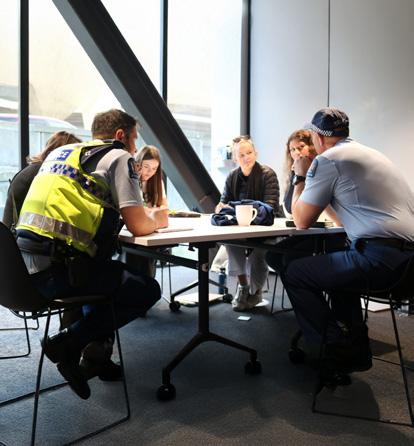



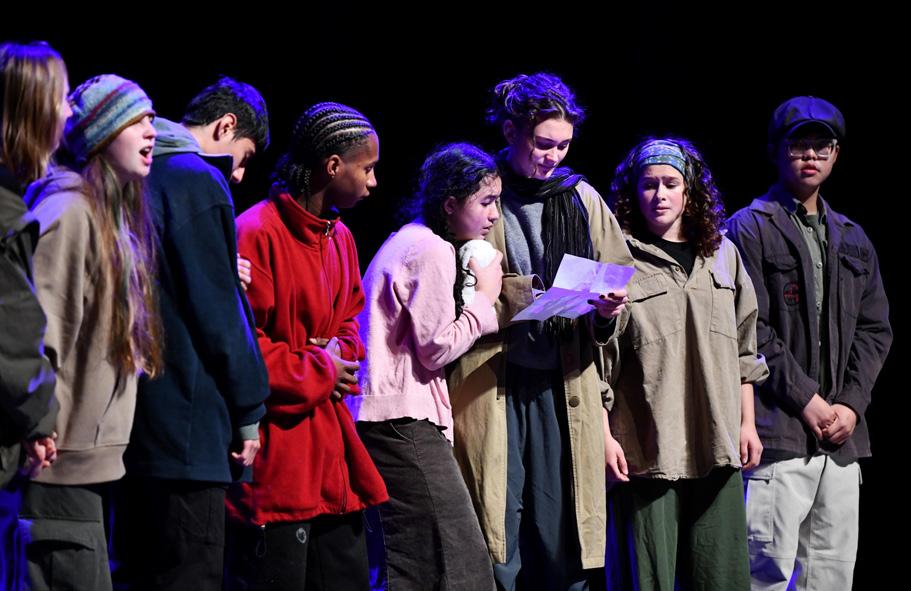


Measuring the impact of classroom release time done differently
Shaping stronger mentoring through data and dialogue

Learning from the MacLean Centre’s approach to inclusion








We send an e-newsletter each fortnight with the latest magazine and all the content that gets published in-between, so you can continue to explore positive education stories and case studies from your peers and colleagues.
You can also check the latest vacancies, notices and professional, learning and development opportunities. Read Education Gazette | Tukutuku Kōrero when it’s fresh, and when it suits you.
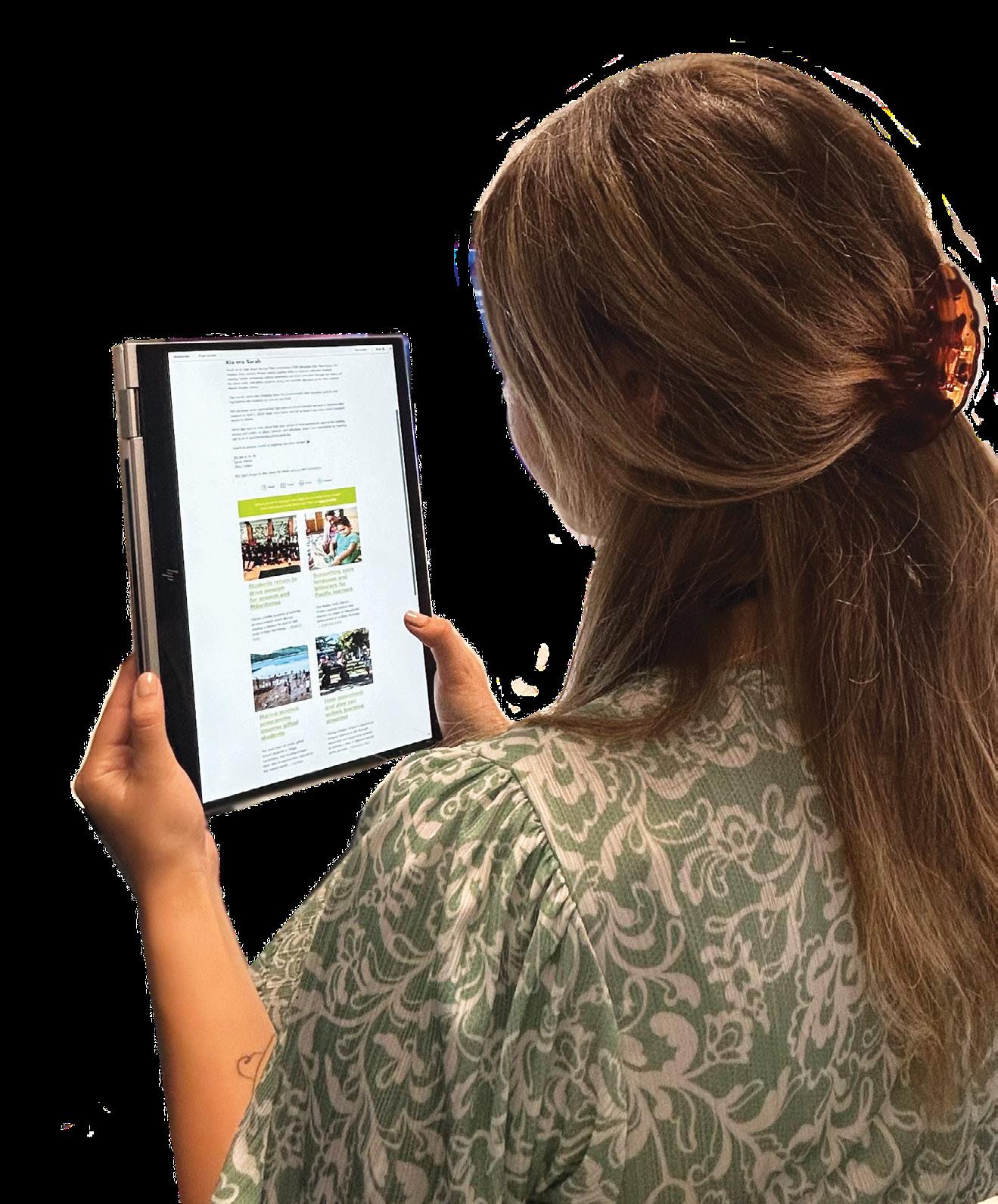
PUBLISHED BY
Education Gazette is published for the Ministry of Education by NZME. Publishing Ltd. PO Box 200, Wellington. ISSN 2815-8423
All advertising is subject to advertisers agreeing to NZME. Advertising terms and conditions www.nzme.co.nz/about-nzme/ terms-conditions
KEY CONTACTS
Editorial & feedback gazette@education.govt.nz
Display & paid advertising
Jill Parker 027 212 9277 jill.parker@nzme.co.nz
Vacancies & notices listings Eleni Hilder 04 915 9796 vacancies@edgazette.govt.nz notices@edgazette.govt.nz
STORY IDEAS
We welcome your story ideas. Please email a brief (50-100 words) outline to: gazette@education.govt.nz
DEADLINES
The deadline for display advertising to be in the 15 September 2025 edition of Education Gazette is 4pm on Friday 29 August 2025.
gazette.education.govt.nz
In this edition of Education Gazette, we explore how data, evidence and insights are shaping education practice, initiatives and opportunities across the motu; not just as tools for measurement, but as catalysts for meaningful change.
From mentoring models built around feedback and collaboration, to leadership programmes grounded in reflective practice, educators across Aotearoa are using insights to strengthen relationships, grow capability and guide development. Explore how principals are gaining greater control over digital security, how researchers are tracking the long-term impact of early learning interventions and how data is being used to reimagine classroom release time. We also examine how research and monitoring is helping to measure the impact of alternative education and guiding responsive change in complex learning environments.
Importantly, this edition reminds us that data is not just about numbers. It’s about stories, voices and lived experiences. From rangatahi reshaping Shakespeare to reflect modern-day displacement, to young women stepping into infrastructure careers through Girls with Hi-Vis, we see how insights can illuminate pathways that might otherwise remain unseen.
As always, we hope these stories spark reflection and conversation in your own school, kura, or early learning service. How are you using evidence to guide your practice? What insights are helping you grow? We’d love to hear from you.
Ngā mihi nui, Sarah Wilson Ētita | Editor

At St Francis Xavier Catholic School in Whangārei, classroom release time has been reimagined as an engine for connection, leadership and enriched learning. Through Tuakana Teina Time, mixed-age whānau teams work with specialist teachers in a programme that is purpose built to strengthen relationships, grow student leaders and deliver a rich, values-aligned curriculum.
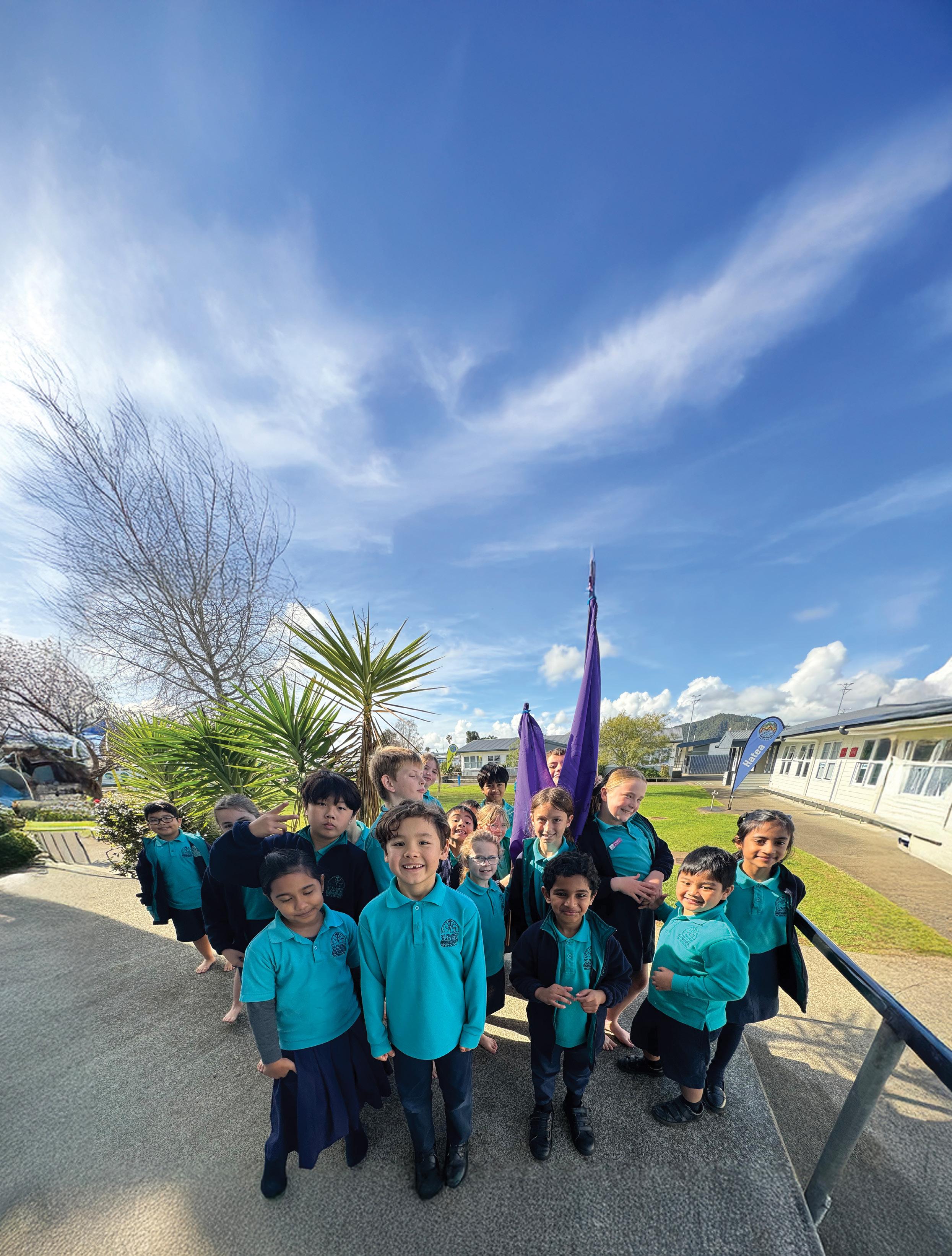
At St Francis Xavier Catholic School, ākonga are grouped into five whānau teams, which sits well with their approach to classroom release time.
At St Francis Xavier Catholic School in Whangārei, classroom release time is a key driver of connection, leadership and learning.
Through a schoolwide initiative called Tuakana Teina Time (TTT), students across all year levels come together in mixed-age whānau teams to learn, lead and grow alongside one another.
It’s an approach that turns release time into something far richer than cover for teacher planning. It is a deliberate, values-led programme that strengthens relationships, builds student leadership, enriches the curriculum and creates visible culture shifts across the school.
Principal Bernadette Hall says rather than slot in more relievers, they asked, “What if we created something that aligned with our school’s values, our special character and helped strengthen relationships?”
Values-led
Bernadette is clear about the foundation stones of the programme, saying it’s about building quality, real-time tuakana-teina relationships, access for tamariki to a full curriculum and valuing expert teachers within the school.
The tuakana-teina approach sees older or more experienced students (tuakana) guide and support younger ones (teina).
“The tuakana-teina approach was the right fit because our school year levels are already structured into whānau teams,” says Bernadette.
“Each team has all year levels from Year 1 to Year 6, with buddy systems in sports and buddy reading already in place. TTT takes this to the next level, with full-day mixed grouping and rotations in sports, STEM, drama, dance, music, religious education and art.”
The approach works well within St Francis Xavier’s five whānau teams of Manaia, Parihaka, Hatea, Kauika and Pukenui, all named after areas in Whangārei.
“It’s meant our students can better identify with their whānau team, learn the meaning of their whānau name, its history, and align future activity and collaboration in a more cohesive way.”
Through TTT, this natural mentoring is taken further. The days start and end together with Mass, karakia, waiata and shared kai in the St Joseph’s Room; a rhythm that strengthens whanaungatanga and reflects the school’s Catholic character.
“Religious education is integrated into other areas of study through the liturgical year,” says Bernadette.
“Art and performance can reflect religious education as well, through storytelling, drawing, re-enactment of events, or celebration performances of liturgical events.”
The shift began with a conversation that would define the success of TTT.
“I met with four of our contracted relievers to see if they would be keen to use their specialised skills in a different way; a way that meant they worked together as a team, each teaching their speciality to a whānau team once a week.
The four release teachers – Emily Nakouzi, Brad Kini, Renee Proctor and Gaylene Smith – were on board straight away, bringing expertise in music, drama, art, STEM, physical education and religious education.
“It enabled the four to be a team themselves, not working in isolation as contracted release personnel. They were given full trust to design, discuss and plan for TTT days,” says Bernadette.
The St Joseph’s Room became their hub, a gathering place for students, a base for resources and the heart of the day’s flow. From there, students moved to different parts of the school.
“Art would occur in a vacant classroom, drama and dance in the parish hall, STEM in the science space.”
The timetable was crafted so each whānau had two of their five CRT days per term dedicated to TTT, with the other three kept flexible for teacher needs such as testing or professional development.
“If the term was less than 10 weeks, we doubled up and had TTT run twice a week to accommodate that.”
“We wanted to create something that felt like us, something that reflected our values, strengthened our school culture and delivered great learning.”


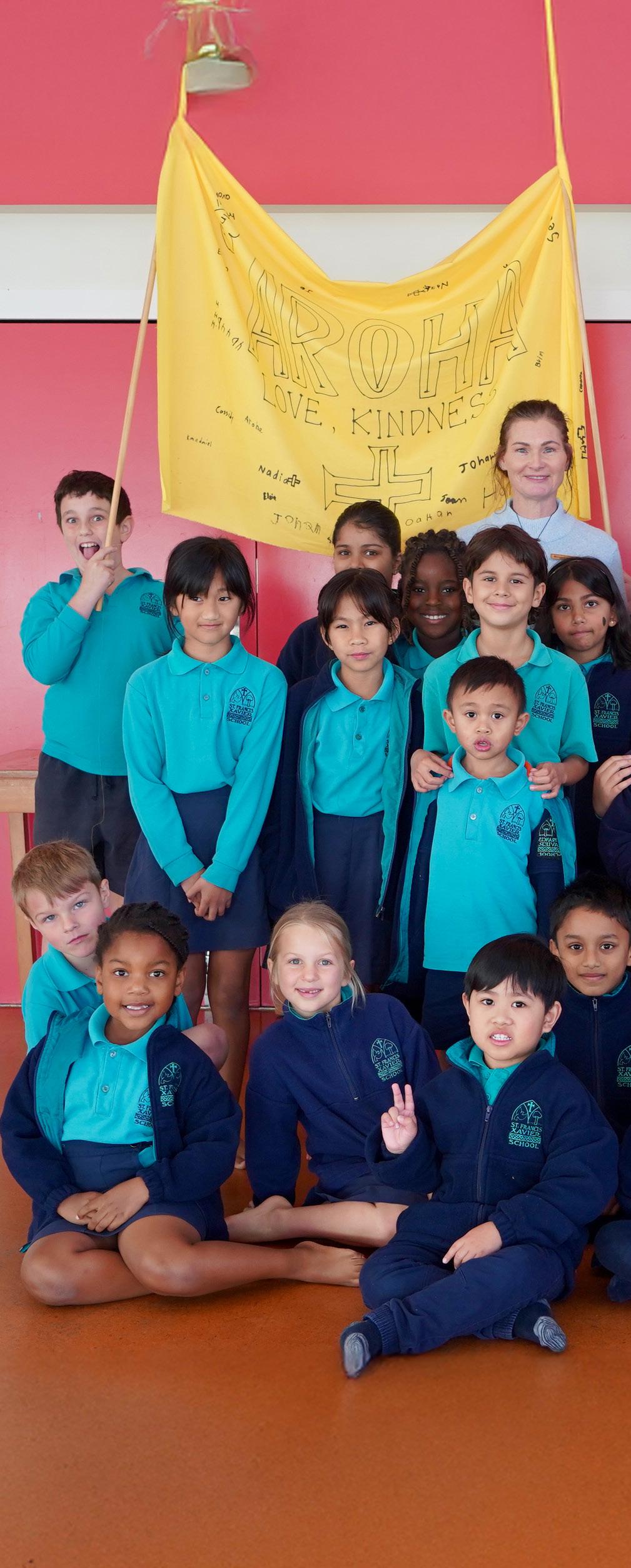
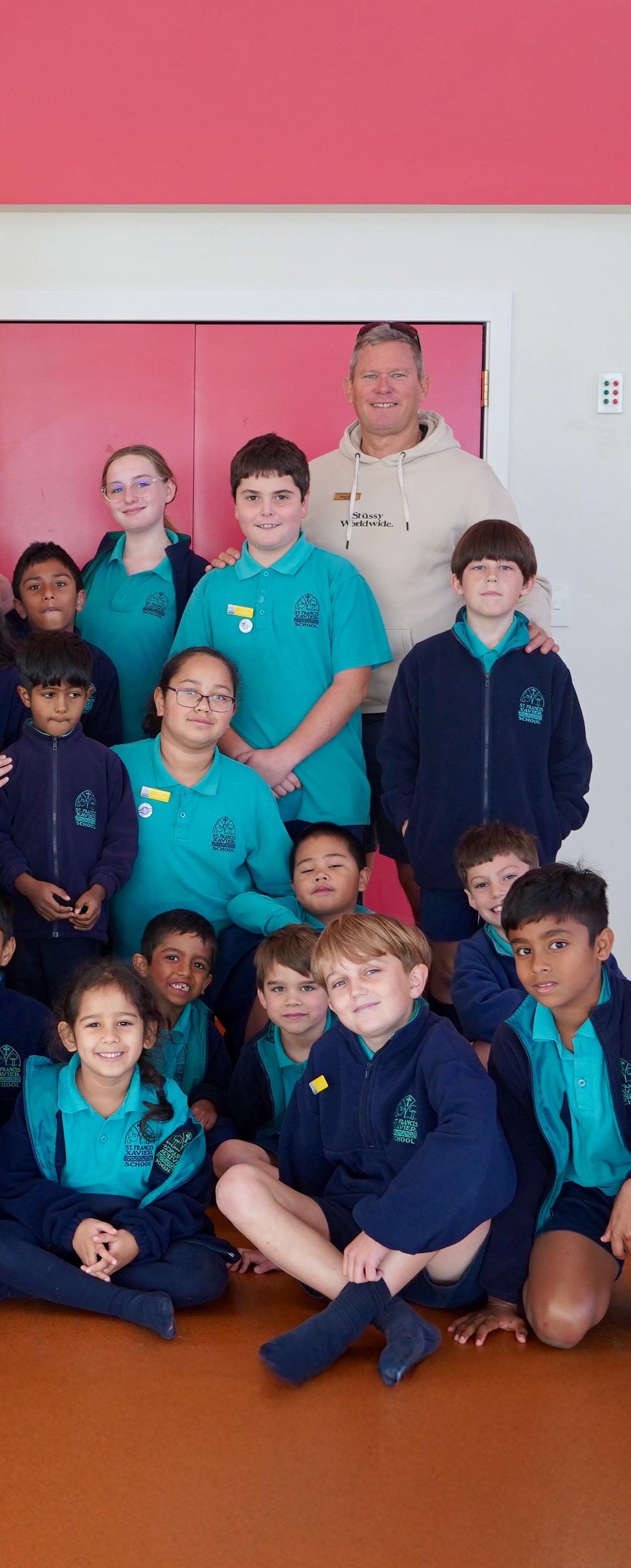
Introducing a schoolwide change required preparation, buy-in and trust.
“We reiterated to staff that TTT did not take away from their CRT in any way, but two of those CRT days a term would look different for the students.”
Professional learning was also key, and ideas for this started in term 4 2024. In 2025, the principal and leadership team agreed to work with Momentum Learning on change and school culture as an investment in continued positive practice through change. This was backed by the school’s board.
TTT is built on clear evidence, including student voice and pastoral data which showed new entrants, ESOL learners and some juniors felt anxious or disconnected early in their schooling.
“A pattern emerged showing that younger students were more engaged when they felt known and supported by older peers, and that frequent absenteeism may be better supported by a stronger tuakana-teina approach.”
This shaped decisions such as selecting tuakana for empathy, grouping teina for natural connection and co-designing activities with tuakana input.
“We intentionally selected tuakana students not just for academic success but for empathy, cultural grounding and relational strength,” say Emily and Gaylene.
From the outset, TTT was structured to generate both qualitative and quantitative evidence.
“We collect student surveys, reflections, focus groups, teacher observations, anecdotal feedback, PB4L behaviour data, attendance tracking and classroom engagement reports.”
The goal is to support TTT to be not just relationally positive, but making tangible differences to student belonging, behaviour and learning.
Teachers report that students are more engaged, better behaved and genuinely excited on TTT days.
“Students show a deliberate, positive, engaged attitude to their learning in TTT sessions with all teachers,” says Bernadette.
Classroom teachers notice that quieter students often come alive in mixed-age settings, and tuakana take pride in leadership roles.
“Younger students now recognise more students outside of their own classrooms who are in their whānau teams … older students feel empowered as role models and it has raised the confidence of our Year 5 and 6 ākonga to collaboratively lead with pride and purpose.”
Bernadette says TTT is enriching areas that can be difficult to fit into busy timetables, particularly arts, drama, music, STEM, and a much wider implementation on the delivery of religious education for understanding.

“Learning of new dances of whole whānau teams was shared in the Matariki school concert and full school dance on whānau celebration day to the whole community. We have rotating art displays in our communal space, continuously updated with student creativity and skill progression.”
Performances at Matariki, the Northland Marimba Festival, church choir services, and cultural evenings showcase the learning. “The mahi and skills aren’t just kept behind closed doors,” beams Bernadette.
Teachers link the programme to growth in key competencies:
» Relating to others: improved collaboration and empathy.
» Managing self: responsibility for roles and tasks.
» Participating and contributing: active involvement in cultural and community life.
“The tuakana-teina approach undoubtedly develops the key competencies,” adds Bernadette.
“We see initiative, positive relationships, active participation, aroha and thoughtfulness of others, and growth in independence and resilience – particularly for the teina.”
“We get to learn a Matariki dance and do cool activities,” says Leon, age 10.
“I help younger children. I get to be a leader,” says Aidan, age 8.
“Big kids are helpful – they listen and show us how to do things,” says Anaya, age 5.
One challenge has been changing some teachers’ mindsets so they view TTT days as genuine learning time, not an interruption to ‘core’ subjects.
“Music, art, RE, STEM, adventure-based learning and dance are as important as other curriculum areas, and allow all students to shine,’’ says Bernadette.
Her advice is to choose your team carefully, keep the team consistent, timetable well in advance, and ensure strong principal support.
“Seek teachers for TTT who have known strengths or leadership in particular fields … you don’t want to be switching out TTT teachers throughout the year. Choose team players who will plan, give feedback and manage students well.”
In 2026, the school will allocate a larger budget to TTT to expand performance and community engagement opportunities.
“We intend to keep this programme growing and going. Teachers now enjoy and look forward to their release day together as a team … and their students look forward to it too.”
» Student voice and pastoral data showed new entrants, ESOL learners and younger students needed stronger peer connections.
» Behaviour and engagement data indicated that older peer support could reduce playground issues and boost attendance.
» Existing whānau team structures provided a strong foundation for mixed-age mentoring.
Evidence collected
» Student surveys, reflections and focus groups tracking belonging, confidence and leadership growth.
» Teacher observations on engagement, collaboration and self-management.
» PB4L behaviour records showing reduced incidents during TTT days.
» Attendance data indicating improved participation for some previously reluctant students.
Early impact
» Increased oral language and participation in discussions.
» Stronger tuakana leadership skills: empathy, patience, initiative.
» Teina showing greater confidence, independence and resilience.
» More students contributing to school events, cultural performances and community activities.
» Teachers report higher-quality, more collaborative CRT time.
» Consistent, specialist release team with strong cultural and relational grounding.
» Embedded in existing pastoral and cultural structures.
» Designed to serve both student learning and teacher wellbeing.


For 40 years, Kaitiaki o Ara | SADD (Students Against Dangerous Driving) has empowered rangatahi to lead road safety initiatives in their schools and communities. As the movement marks its 40th anniversary, students and educators reflect on its impact – and the data shows their voices are more vital than ever.
Road trauma is the greatest cause of harm for 16 to 24 year olds. Young drivers make up only seven percent of drivers, but 14 percent of crashes.
Forty years ago, a group of students at Mahurangi College decided they’d had enough of losing friends to preventable crashes. They took action and with that, Students Against Drunk Driving (SADD) was born.
Since 1985, SADD has grown into a nationwide, youth-led movement now known as Kaitiaki o Ara | SADD (Students Against Dangerous Driving). Today, thousands of rangatahi across Aotearoa are continuing that legacy – leading road safety initiatives in their schools and communities and tackling issues far beyond drunk driving, including speed, distraction, fatigue, drugs and risky decision-making behind the wheel.
For many students, joining SADD is a defining part of their high school years. It’s an opportunity to lead, influence their peers and take real-world action on an issue that impacts their lives directly.
SADD’s deputy youth representative, Olivia Adie, says working alongside people who are passionate about the same thing and who have the same goals has been great.
“Getting to meet with community partners such as police and developing my communication skills has been excellent – they are great life skills to have.”
Led by students, supported by schools
The strength of SADD lies in its youth-led approach. Students plan and deliver their own road safety awareness activities, such as pledge walls, distraction obstacle courses, poster and chalk displays, assembly presentations, even dress-up days, with support from a team of regional programme delivery leads and a huge suite of online resources.
Activities are designed to be flexible, creative and inclusive of different learning styles, making sure every student can contribute in a way that suits them.
Teachers play an important supporting role, often as contact teachers or mentors; but the beauty of SADD is that it’s designed to be student-led and not another demand on teachers’ time.
“SADD is an organisation that empowers the students to take control of their own fates on the road,” says Jason Cressingham, contact teacher at Te Pae Pae o Aotea in Taranaki.
“Through leading by example and creation of awareness, the youth of today are becoming leaders of the Road Safe programmes in their communities.”
Jason says the annual conferences are a highlight, and an opportunity for like-minded students to learn and share ideas to get the road safety message out into the communities.
“Having had the privilege to attend and observe two of the conferences has left me totally encouraged that we have amazing youth capable of sharing this message.
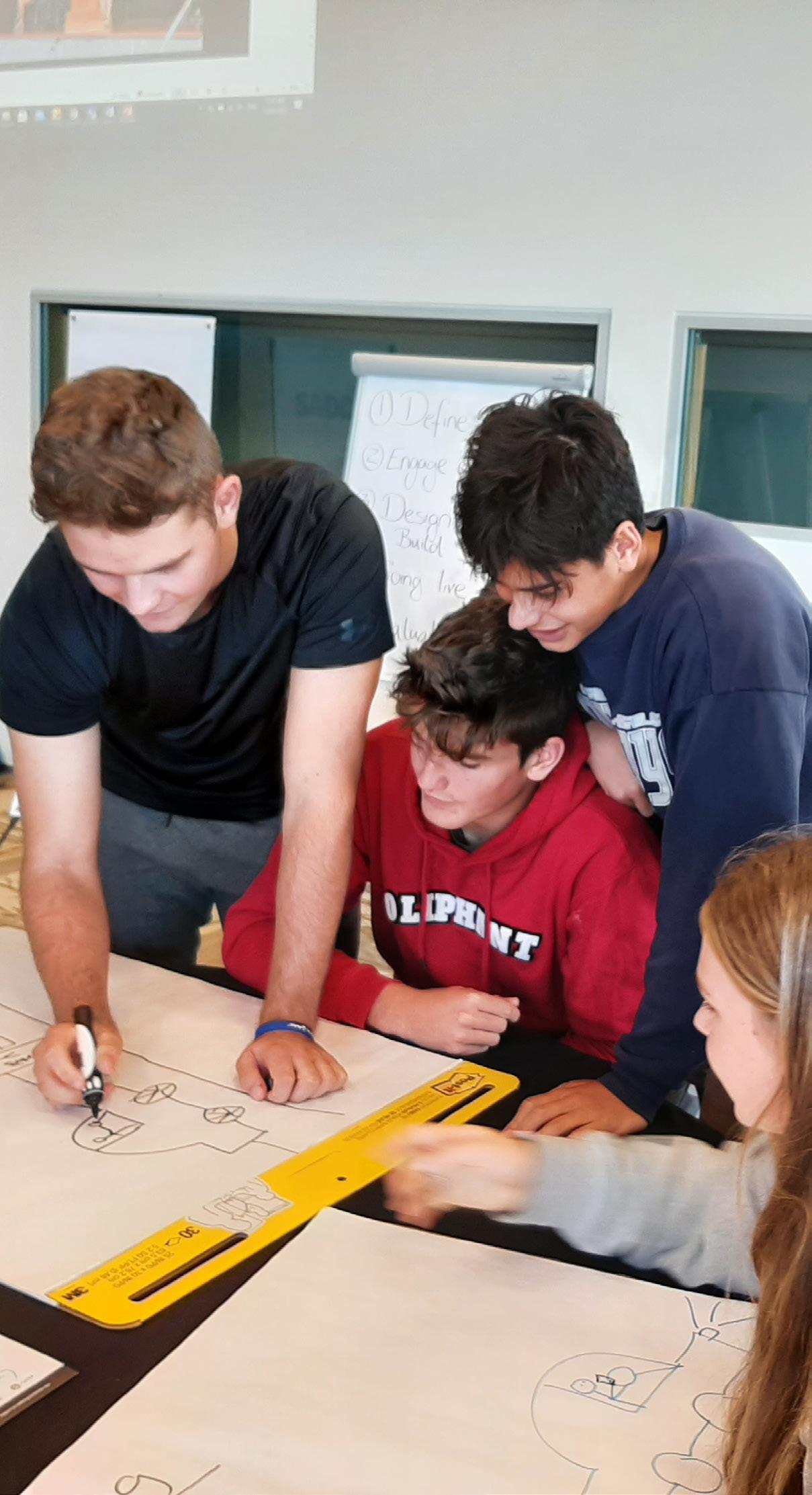

“The role of being the teacher contact to the SADD students is not overly onerous. You act as a bouncing board for your SADD group and assist with the background organisation if they require it.”
Jo Melton, a long-time SADD supporter at Te Puke High School, has been involved with SADD for many years.
“It is an organisation close to my heart, having lost a daughter to a drunk driver … We’ve run activities in SADD Week and Road Safety Week for 25 years.
“We used to act out dramatic crashes on the field … now we focus on encouraging safe driving with students pledging they will not go in a car with a dangerous driver. I have seen an improvement in student awareness of safe driving over the years.”
SADD is a movement that not only saves lives but provides rich, authentic learning experiences that can link directly into learning.
From business studies and English to health, social studies and geography, students across Aotearoa have found meaningful ways to tie SADD and road safety education into their classroom learning.
In Masterton, James focused his geography research on road safety along a stretch of road meaningful to his whānau, using mapping and data to explore local risks and solutions.
Hayley, a SADD leader from Gisborne, integrated SADD into a business studies project by developing a

student-led social enterprise campaign promoting safe driving.
Through this learning, students deepen their understanding of important social issues and learn transferable skills in communication, leadership, critical thinking and community engagement.
“Having been out of high school for over four years now, I still reflect fondly on my involvement with SADD/Kaitiaki o Ara in my final years of school,” says former SADD national leader Ben Bonne.
“I joined to make a positive difference in my community … Being a SADD national leader allowed me to push myself outside my comfort zone as a leader by engaging with big community stakeholders, as well as networking with other passionate young leaders.”
Beyond its core focus on road safety, SADD plays a powerful role in shaping the future of young people by fostering a wide range of life skills and career-ready capabilities.
Through their involvement, students build confidence in safe decision-making, strengthen their problem-solving abilities and gain experience in areas such as event planning, campaign design, evaluation and teamwork.
Many also explore career interests through exposure to emergency services, public health, education and community development sectors.
SADD supports students in understanding the real-world importance of driver licensing and compliance, helping them take steps toward independence and employability.
“When applying for internships and jobs, I often draw on my SADD experience,” says Tayla Hill, former SADD national leader and youth representative to the Board of Trustees, now studying environmental engineering at the University of Waikato.
“From being on the board to speaking at conferences, I’ve gained transferable skills that help me stand out. My involvement shows I’m not just technically capable – I also bring leadership, initiative and an understanding of community needs, especially from a youth perspective.
“Even while I was still at school, SADD gave me opportunities to work alongside police, local councils and road safety partners. Those experiences taught me how to communicate professionally and build relationships.”
SADD also works alongside other programmes like RYDA (Rotary Youth Driver Awareness), providing a wraparound approach where students continue the kōrero long after external workshops, embedding the learning through action and leadership.
With over 250 schools involved today and an estimated 400,000 young people positively influenced by SADD’s message over the past four decades, SADD is not just a programme; it’s a legacy of youth action and leadership that continues to evolve.
And the need for youth voices has never been more urgent. Recent data commissioned by the AA Research Foundation shows that 66 percent of young drivers have admitted to speeding in 50 kmh zones, 23 percent have used social media while driving and one in three have been in a crash in the past five years.
As SADD marks 40 years, the message is clear: when students lead, powerful change follows.
Visit the SADD website to read more about road safety in the curriculum.
Read more about James’ geography research on road safety.
Read more about how Hayley integrated SADD into her Business Studies project.
Learn about SADD’s Careers and Pathways tools which connect student experiences to future study or work.

Tayla presents at a conference.
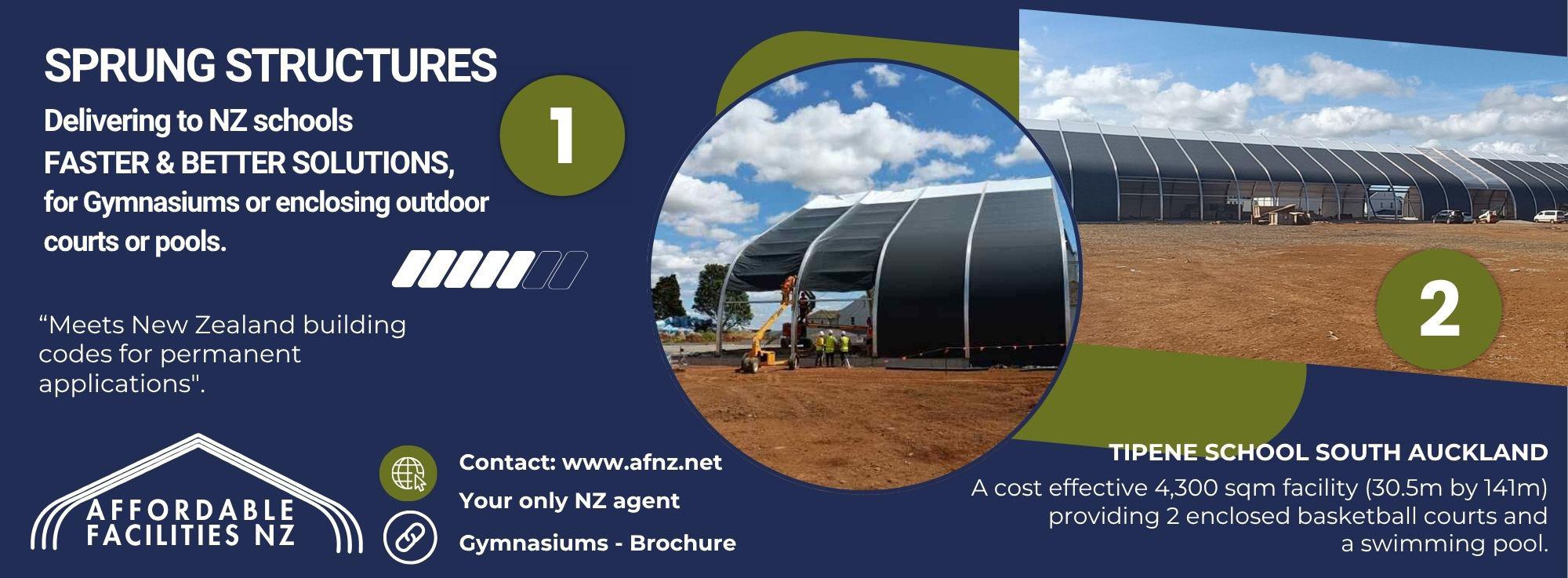
Professor Elaine Reese and a team of academics are leading the ongoing Kia Tīmata Pai (Best Start) study, a national study investigating how early support for oral language and self-regulation can shape the learning, wellbeing and brain development of tamariki.
Elaine explains how the research is tracking outcomes from toddlerhood through early

ow can we best support oral language and self-regulation in tamariki from early childhood? Findings from the Dunedin Longitudinal Study and Growing Up in New Zealand highlight the importance of both skill sets for lifelong learning and success.
Kia Tīmata Pai (Best Start) study is a national trial in 136 early childhood centres across Aotearoa New Zealand, involving more than 1,600 tamariki and 1,800 kaiako. It began in 2021 with the aim of promoting children’s oral language and self-regulation through two professional development programmes: ENRICH and ENGAGE.
Kia Tīmata Pai was founded by Professor Richie Poulton, and I now lead the study with a team of academics and
community partners from Otago, Auckland, Waikato, and Te Herenga Waka universities, supported by Methodist Mission Southern, BestStart Educare and National Libraries. ENRICH focuses on serve-and-return interactions during book reading, everyday conversations and sound play to support oral language, emergent literacy and mathematics development. ENGAGE uses games and activities to foster cognitive, emotional and behavioural self-regulation. Both programmes are evidence-based, developed in Aotearoa New Zealand, and aligned with Te Whāriki. ENRICH connects with the oral language resource Te Kōrerorero / Talking Together, while ENGAGE aligns with the social and emotional resource He Māpuna te Tamaiti
“Children with strong storytelling, sound awareness and numeracy skills tend to find reading and maths more accessible.”
Early findings from the toddler phase of Kia Tīmata Pai show that ENRICH supports children’s oral language, book interactions, self-regulation and social skills by age three.
Researchers are now analysing the preschool phase (ages three to five) to assess continued benefits of ENRICH and the added impact of ENGAGE on oral language, emergent literacy, mathematics and self-regulation.
Children with strong storytelling, sound awareness and numeracy skills tend to find reading and maths more accessible. Similarly, those with strong memory and emotional regulation are better equipped to participate and learn effectively in classroom settings.
The study is now entering an exciting new phase, supported by $3 million dollars in funding from the Royal Society Te Apārangi.
This phase will assess academic skills (reading and mathematics), learning engagement and self-regulation at ages six and seven. It will also explore brain development in over 200 children using non-invasive technologies during school-like tasks.
These insights will help shape school transition programmes and deepen our understanding of how to support tamariki across both ECE and primary school.
As study participants transition to primary schools nationwide, schools may be invited to take part. Teachers of participating children will be asked to complete a 15-minute questionnaire per child and a single five-minute questionnaire about their teaching practices.
EMPLOYMENT OPPORTUNITY:
Head of Peace Education
Is this you?
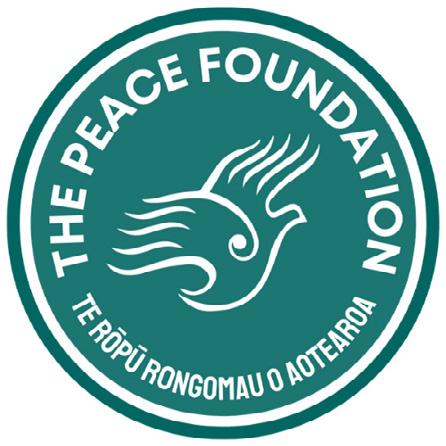
Teachers will receive a koha, and schools will be entered into a raffle for cash prizes. This is a valuable opportunity to contribute to research that supports smoother transitions and better outcomes for tamariki.
Kia Tīmata Pai is the first large-scale trial to test the separate and combined impacts of oral language and self-regulation enrichment on learning, behaviour, socio-emotional skills and brain development.
The findings will inform educational practices in Aotearoa New Zealand and beyond. For example, a similar programme to ENRICH in Denmark has shown long-term benefits for language, reading and mathematics – but lacks a selfregulation module like ENGAGE.
The combination of both programmes may offer even greater outcomes for tamariki.
To learn more, email beststart.study@otago.ac.nz.
Self-regulation connects through trusted relationships: The ENGAGE programme is now in action right across Aotearoa with a recent expansion into Te Tai Tokerau.
More tamariki to learn self-regulation skills through play: An evidence-based programme which uses play to help tamariki develop important selfregulation skills is undergoing a significant expansion across Aotearoa.
The Peace Foundation / Te Rōpū Rongomau o Aotearoa delivers innovative training in peer mediation to schools throughout Aotearoa. A registered charity, the Peace Foundation is the only national organisation which offers peer mediation programmes for primary, intermediate and secondary schools which are contemporary and culturally responsive.
We are looking for an innovative and committed educator to fill the key role of Head of Peace Education. This is a full time, once in a career
opportunity and will commence mid January 2026. If you are passionate about peace education and making a positive impact in school communities at a national level, then this could be an exciting new role for you. There will be opportunities to grow and diversify your experience and expertise in the education sector without being limited by the Ministry of Education parameters.
FOR MORE DETAILS GO TO: www.peacefoundation.org.nz/ get-involved/job-vacancies

Now in its 10th year, Girls with Hi-Vis is a pioneering programme that connects ākonga with hands-on experiences in infrastructure and trades. Led by Connexis, the initiative is helping shift perceptions and open career pathways for young women across Aotearoa.
This year, more than 500 secondary school students from across the motu have attended Girls with Hi-Vis events.
Hosted by industry leaders like Fulton Hogan and Contact Energy, the events included workshops, site visits and presentations that helped ākonga wahine learn basic trades skills and explore what a career in infrastructure can offer.
Connexis, a leading infrastructure trades training provider, facilitates the events. The company launched the initiative in 2015 after employers asked for help attracting more women into male-dominated sectors.
“When we began Girls with Hi-Vis, it was because employers had recognised the potential of employing more females in trades but were struggling to attract them to apply for roles,” says Connexis executive director, Kaarin Gaukrodger.
Kaarin and her team knew there were ākonga wahine looking for career pathways beyond those traditionally offered in schools. The first event sparked a movement.
“Girls with Hi-Vis now directly connects students with local employers with active opportunities for employment and apprenticeships, which has without doubt helped the upswing in female representation, as shown in our training programme enrolments,” says Kaarin.
In June, students from 79 schools donned high-vis gear to visit highway and public walkway construction sites, geothermal and hydro power stations, and more.
Ākonga met women working in a range of trades and learned about the qualifications and roles available in each sector. They also gained hands-on experience in traffic management, cable joining, working at height and operating heavy machinery.
“Students come to Girls with Hi-Vis from school, where most of their learning is classroom based,” says Kaarin.
“Being exposed to real working environments, often at some of the country’s major infrastructure assets like power stations and roading projects, opens them up to a whole new practical way of learning.
“A classroom environment doesn’t suit everyone,” she continues. “Being given the opportunity to learn on the job really fires up students’ enthusiasm for trades and workbased apprenticeship training.”
Line mechanic Natalie Hughes agrees. “Girls with Hi-Vis is important because it gives girls a chance to try things they wouldn’t usually expect to do,” she says.
Natalie attended a 2022 event while studying at Trident High School in Whakatāne. She found the practical lessons inspiring and credits the experience with sparking her interest in trades.

“I really enjoyed being a bucket operator and controlling a crane,” she says. “The best thing was the pole top rescue. I really enjoyed the hands-on nature of the work.”
That same year, Natalie entered a Gateway programme through a Connexis initiative that allows ākonga to work on trades qualifications while still at school.
She began training as a line mechanic with Horizon Networks and joined the company full-time after finishing school. She’s now set to complete her apprenticeship and regularly attends Girls with Hi-Vis events to encourage other ākonga to take up the opportunities on offer.
To Kaarin, stories like Natalie’s are proof of the programme’s success.
“The most obvious marker of success is that we now have women who’ve previously attended Girls with Hi-Vis events coordinating and participating in them for their employers as professional tradies,” she says.
She hopes to see more wahine ākonga enter infrastructure trades – and more ākonga in general for whom this may be seen as a ‘Plan B’ option.
“Too often, trade careers are still regarded as a ‘last resort’ for school students who might be struggling academically,” she notes.
“By connecting students directly with local employers, through events like Girls with Hi-Vis and Gateway, Connexis can show them that there are great opportunities to be found.”
Girls with Hi-Vis began in 2015 with just three electricity companies and 50 students. In 2025, 18 companies from a range of sectors participated, and the number of students involved has grown fifteen-fold.
Most of the 2025 employers are repeat participants, many of whom have taken part almost every year. Kaarin says this is a clear indication of the ongoing value they see in the event.
She adds that employers in civil, energy and water industries have recognised the potential of connecting directly with high school students as they make career decisions.
“[They’ve] recognised the platform it gives them to demonstrate career opportunities that allow young women who may not enjoy or thrive in classroom-based study, or may not want office-based careers, to work in practical, skills-based trade careers.”
Industry data supports the programme’s impact. In the past five years, female trainees enrolled in civil, energy and water qualifications rose from eight to 14 percent. While Kaarin acknowledges this increase can’t be solely attributed to Girls with Hi-Vis, it reflects a more proactive approach to recruiting female apprentices.
Connexis also collects feedback from students and school staff after every event. This year, 87 percent of respondents said they had little or no knowledge of infrastructure before attending, and 41 percent had not considered a career in the sector.
However, 51 percent of students surveyed said they could now see themselves pursuing a career in infrastructure and trades.
“Each year these survey results also form part of the planning process for future events. This feedback is always passed on to the employers to help them tailor their events to engage and interest the students,” says Kaarin.
Based on partner suggestions, this year’s events were capped to involve fewer students, helping each participant receive a more involved experience.
“We also ensure that every employer hosting Girls with Hi-Vis events has actual opportunities available,” says Kaarin.
“This helps build tangible results and sends the message that Girls with Hi-Vis isn’t just about presenting general career possibilities – students see there are actual job leads or training opportunities.
“Attracting more females into infrastructure trades is always going to be a long game,” she adds. “But it starts at the grassroots level by changing the conversations we have with young women about what they envisage for themselves and what’s available to them.”
Educators share Kaarin’s enthusiasm. Karen Caso, careers and Gateway coordinator at Mt Albert Grammar, attended a recent event in Auckland and was impressed by the opportunities on offer.
“It was great for the students to have hands-on experience of a variety of activities that gave them an idea of what these jobs involve,” says Karen.
“They were able to interact with staff and give different things a go. It was a really informative day for them.”
Natalie encourages ākonga to take part. “If you’re thinking about a trade, just go for it,” she says. “Don’t let the opportunity pass you by.”
“Girls with Hi-Vis isn’t just about presenting general career possibilities – students see there are actual job leads or training opportunities.”

A Hawke’s Bay secondary student learns the basics of digger operation at a GWHV event hosted by TW Construction in Napier.
Top right: Ōrewa College’s Rebecca (left) dons her PPE ready for GWHV with HEB Construction in Auckland.
Right: Meridian Energy electrical apprentice Justin Swanepoel oversees the work of Fiordland College students Hannah and Kelsey at Manapouri hydro power station.



DIGITAL LITERACY
Netsafe’s new resource, co-designed with young people, offers judgement-free ways for students to explore and respond to misinformation, hate and extremism online.
Young people across Aotearoa are navigating a digital world where falsehoods can feel like facts, memes can carry hate and manipulation can look like friendship. They’re seeing it unfold in real time, in feeds, group chats and online games. Increasingly, they are asking not just for protection, but for the skills to understand and respond.
Teachers know this too. Many are seeing subtle shifts
in what students are bringing into classrooms, uncertainty about what to believe, silence around the posts that don’t sit right, or casual references to content that deserves more scrutiny. Teachers want to help. They want to support students to unpack these experiences but often lack tools that reflect young people’s reality.
Headspace Invaders emerged from this shared need. It was developed by Netsafe with rangatahi, and in
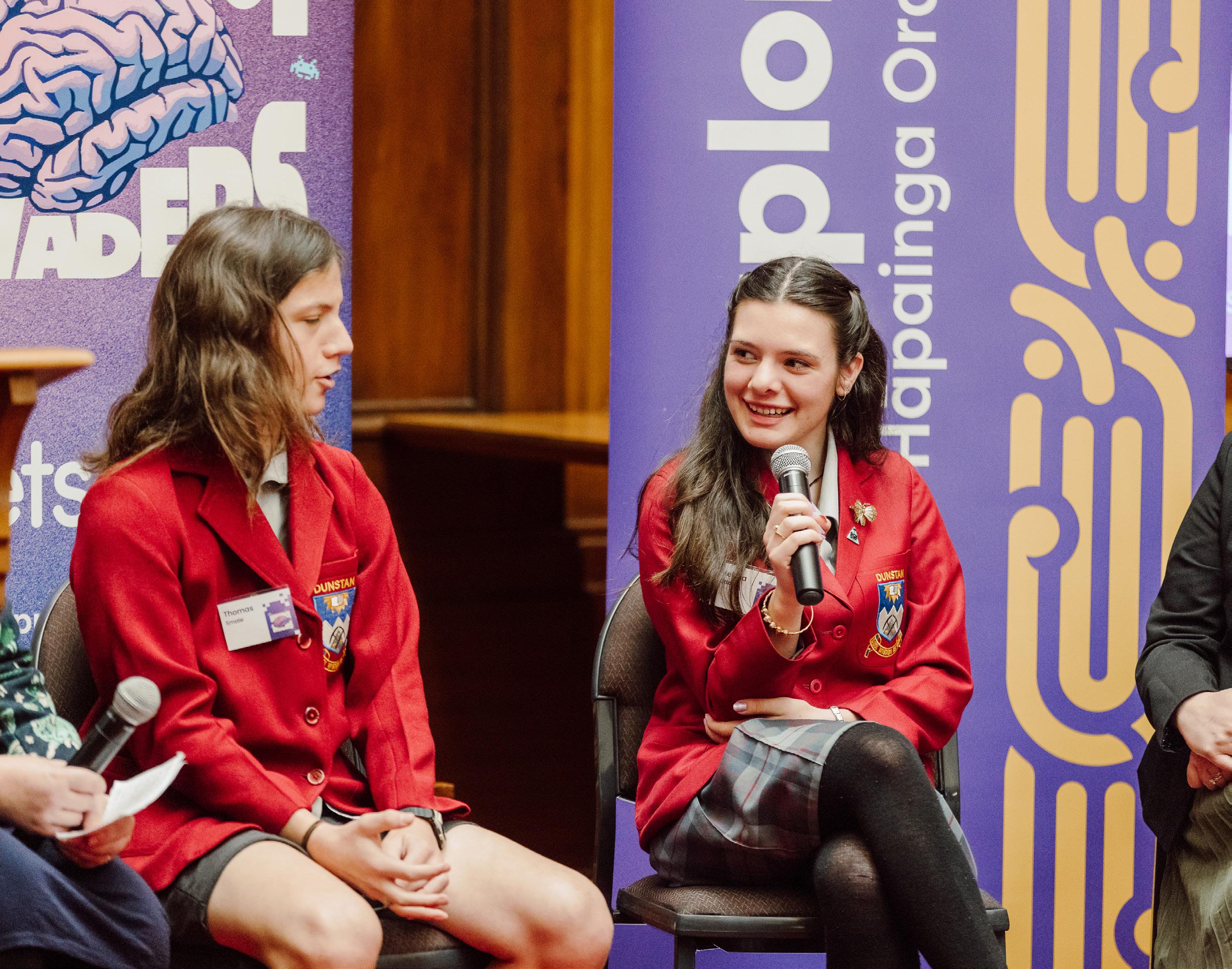

partnership with Youthline, who led the development of the student-facing content.
Subject matter experts, industry professionals and academic partners also contributed to ensure the resource reflects the real challenges young people are navigating online.
Rather than offering top-down warnings, it opens a judgement-free space to explore how misinformation, hate and extremism can show up, and how to respond early, with confidence and care.
Young people aren’t just passive recipients of misinformation and hate; they are disproportionately affected. Netsafe’s 2023 Mis/Disinformation Report found that young people aged 13–29 were more likely than the general population to share misinformation, including unintentionally.
They also reported higher concern about falling for misleading content and a greater desire to build their skills to spot it. The same report identified neurodiverse youth and those from LGBTQIA+ communities as particularly affected.
In parallel, Netsafe’s 2023 Online Hate Speech Report showed that 26 percent of New Zealanders under 30 had experienced hate speech in the past year, twice the national average.
They were also more likely to have witnessed others being targeted, particularly in spaces like gaming chats and influencer comment sections. The content didn’t always look harmful, but students told Netsafe it built up over time and left them feeling uncertain, overwhelmed, or alone.
Rangatahi in co-design sessions spoke about
the awkwardness of pushing back, especially when misinformation or hate comes from someone they know.
One student said, “I know it’s wrong, but I don’t want to make it a big thing, especially if everyone else is laughing.”
Another described the difference it made when “a teacher helped us unpack it instead of just saying it was bad.”
Through interactive, judgement-free activities, Headspace Invaders helps students explore how trust is built online, how content spreads and how emotions can be used to manipulate thinking. There are no right answers, just space to reflect, practise, and build critical literacy.
This platform wasn’t built for young people; it was built with them. From the visual design to the content tone, rangatahi shaped the experience.
One Year 10 student involved in testing said, “This actually makes sense for our lives. It’s not just made by adults guessing what we do online.”
Teachers were involved in the process, sharing what works in their classrooms and what young people are bringing to discussions.
Their feedback helped shape the educator guide, which offers curriculum links, practical discussion prompts and flexible entry points for exploring these topics in context.
Students know that teachers can play a powerful role in helping them make sense of what they see online.
One student put it simply: “When a teacher listens, it makes it easier to talk. We’re not looking for answers, just space to figure things out together.”
Headspace Invaders isn’t about giving students a checklist.
It’s about helping them pause and ask: Why does this feel true? What makes this message powerful? What would I do if I saw this again?
It is designed to help students recognise early signs of harm, reflect on influence and practise the conversations that might otherwise be too hard to start.
How it works
Headspace Invaders includes three core modules:
» Mis/disinformation
» Identity-based harm
» Online extremism.
Each focuses on real challenges young people have said they’re seeing, from false claims shared in group chats to jokes that cross the line into harm.
The content is short, interactive and designed to be used independently on any device. Students work through activities that invite them to make choices, reflect on how they’d respond and think critically about what’s happening around them online.
There’s no scoring, but students do earn coins to stay motivated as they move through a gamified experience that offers practical opportunities to pause and think.
The resource is flexible. Teachers can use a single module or build it into a wider unit, depending on student needs and curriculum goals.
Headspace Invaders includes:
» Interactive student modules
» A teacher guide with classroom-ready supports
» A whānau guide to support conversations at home
» A ‘Truth or Trap’ one-pager with simple tools students can use to check if content has been manipulated or generated by AI.
It’s accessible from any device and ready to support a wide range of classroom conversations.
If you’re keen to bring these conversations into your classroom, start by picking a module that fits your students and giving it a go. The resource is free, easy to use and ready when you are.
Visit www.netsafe.org.nz/headspace-invaders to learn more.
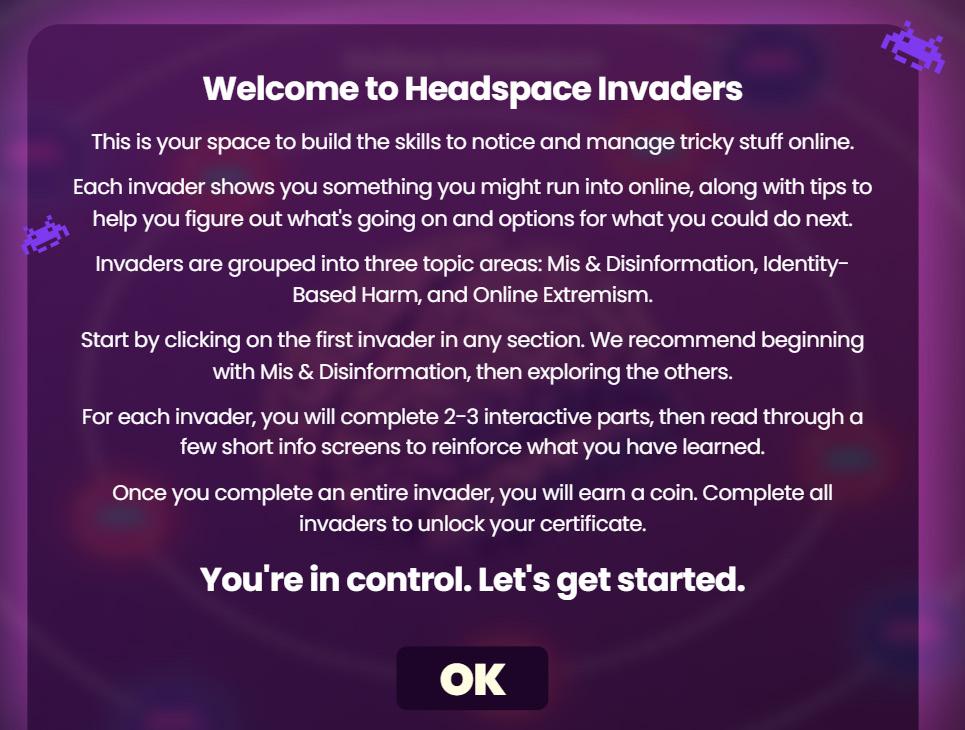
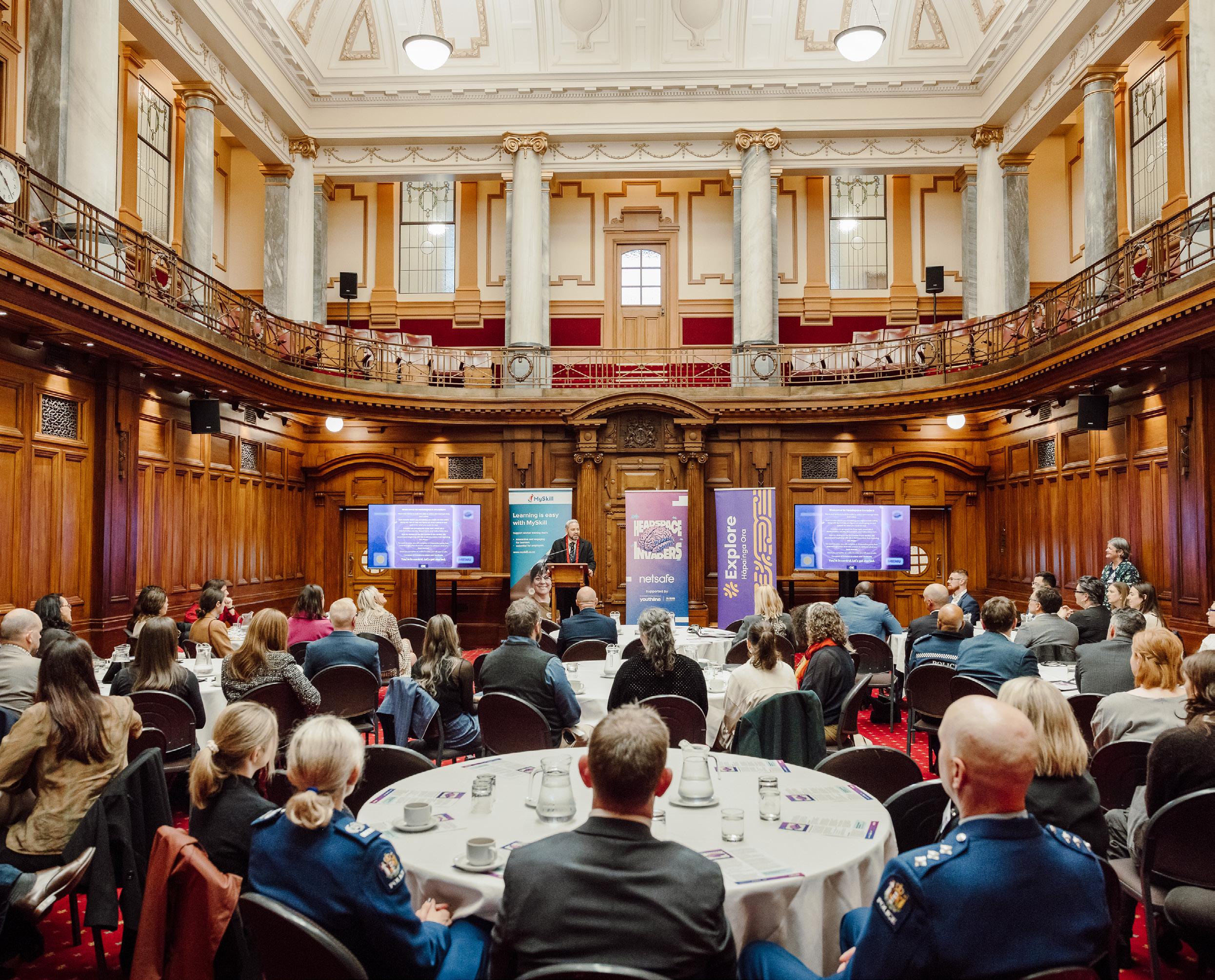
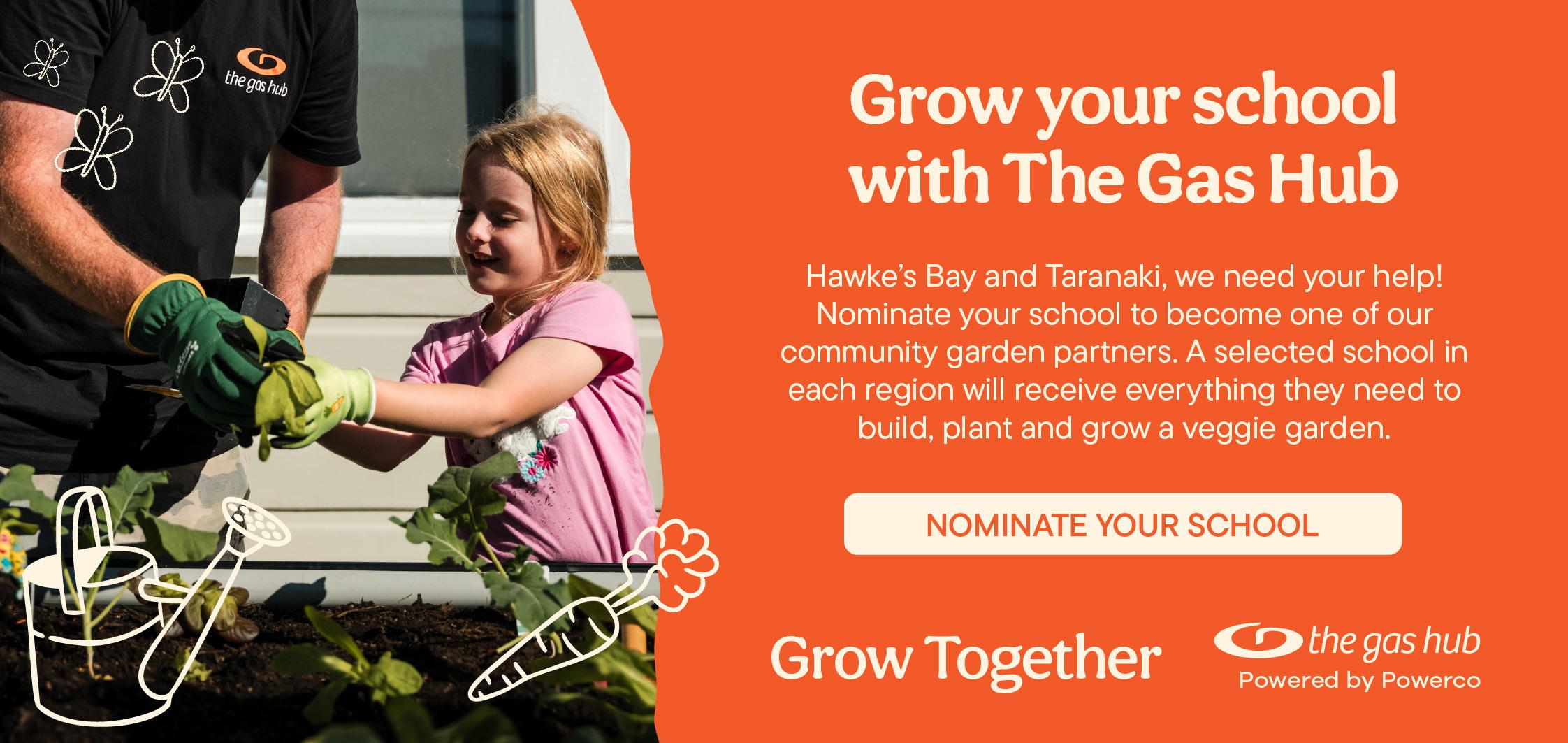

The photos in this article show facilitators and kaiako across various sessions with Te Poipoi Kaiako Mentor Support Programme.
A new mentoring model is helping educators across Aotearoa build stronger professional relationships, deepen cultural responsiveness and grow their own capability. Te Poipoi Kaiako Mentor Support Programme centres mentors in the learning process using data, feedback and collaboration to shape a more resilient and confident teaching workforce.
Te Poipoi Kaiako Mentor Support Programme, funded by the Ministry of Education and provided by Tātai Aho Rau Core Education, is redefining mentoring across Aotearoa by placing mentors at the centre of their own professional learning.
Through data-informed design and collaborative development, the programme is building a more confident, culturally responsive teaching workforce.
Mentoring is often seen as a support role, something done quietly alongside teaching. But Te Poipoi Kaiako flips that narrative, recognising mentoring as a leadership capability. It positions mentors as professionals who deserve their own space for growth, reflection and connection.
The programme’s design is grounded in evidence: national and international research, sector-wide
feedback, and cultural frameworks such as Tātaiako and Tapasā.
It also draws on Teaching Council documents including Our Code, Our Standards and the Guidelines for induction and mentoring and mentor teachers.
Facilitators use a Theory of Change model: if mentors are supported through culturally grounded, relational and practical PLD, they will feel more confident and capable. This leads to stronger mentoring practices and better outcomes for new teachers.
Feedback is gathered at every stage through surveys, focus groups, interviews and analytics from the Ministry’s Education Learning Management System. This data informs everything from the order of learning modules to the content of workshops.
For example, wellbeing was elevated to the top of the programme’s kaupapa after participants identified it as a foundational priority, while curriculum design was reframed as designing learning experiences to better reflect educators’ needs.
Mentors say the programme is “rooted in support and relationships” and value the chance to exchange strategies, ideas and resources with others.
One SCT describes her approach as “working within a team, guiding a team and empowering a team,” while others highlight the tuakana-teina approach as “really empowering.”
Helen, a mentor from Queen’s High School, says the
programme has helped her apply new learning across her teaching and relationships.
“This course highlights the importance of continual growth and the importance of collaboration.”
Kayla from Wānaka echoes this, saying, “Everything I’ve learned is as much of a reminder for my own personal growth skills as it is for growing the skills for other kaiako through mentoring.”
Mentoring across diverse contexts
Data from the programme reveals distinct mentoring patterns across sectors. In secondary schools, uptake is high due to structured frameworks and roles like the specialist classroom teacher (SCT).
These schools often have layered support systems, with mentees accessing guidance from subject mentors, SCTs and heads of department.
Helen, who mentors seven provisionally certified teachers (PCTs), meets with them all once a week, with one-on-one meetings at least fortnightly.
“I do observations and have conversations with the LA mentors to monitor how PCTs are going in the classroom.”
In primary schools, mentoring is often less formalised. Jan from Redwood Primary notes that her role as a learning support coordinator allows her to regularly check in with her mentee throughout the day, creating space for informal but meaningful support.


“This course highlights the importance of continual growth and the importance of collaboration.”
She says being able to drop in for a chat or respond quickly when something is “not quite right” helps her offer timely, effective support.
In early childhood education (ECE), mentoring often falls to centre managers or head teachers, who juggle multiple responsibilities. Courtney from FamilyTies preschool describes how mentoring is embedded in her team’s culture.
“Mentoring is empowering my mentee through observations of their work and ensuring space to try new things before coming together and reflecting for growth for both of us.”
Rural ECE services face additional challenges accessing face-to-face PLD due to distance and resource constraints. In response, Te Poipoi Kaiako introduced online modules and webinars to improve access and equity.
Jan shares that while it initially took time to navigate the Education Management site, she now enjoys completing the programmes and using the resources to support her mentee’s registration journey.
Others say the collaborative PLD workbook and online study options have been invaluable, particularly for fitting professional learning into busy schedules.
Courtney adds that the programme has helped her broaden her perspective.
“This programme has encouraged me to widen my view on education from other sectors and strengthened the relationship between me and my mentee.”
“It was a great refresh and a reminder of the importance of pepeha, whanaungatanga and manaakitanga to create a strong foundation for professional learning relationships,” adds Jan.
Mentors describe the programme as empowering, inclusive and transformative. The tuakana-teina approach fosters reciprocal learning and relational values like whanaungatanga and manaakitanga are woven throughout.
Reflection tools and workbooks help mentors link their practice to the Standards, while webinars and workshops offer space to share strategies and build networks.
One mentor shares how noticing a shift in their mentee’s āhua (disposition, attitude) led to a timely hui and meaningful support, highlighting the importance of relational awareness in mentoring.
Courtney says the programme prompted her to reflect more deeply on Te Tiriti o Waitangi.
“The programme has encouraged me to reflect on Te Tiriti within our documents, not just in my mentorship but also in my practice as a whole.”
Helen reflects on the reciprocal nature of mentoring.
“I wish I had done mentoring earlier in my life. I’ve learnt as much from beginning teachers as they have from me.”
Several mentors say the experience has refreshed their awareness of beginning teachers’ needs, encouraged them to “keep the space available” for their mentees and given them renewed confidence to support evidence gathering for certification.
Kayla adds she is taking some ideas back to her team and bringing more next time, noting that it will be empowering for her colleagues too.
Others highlight the benefit of hearing “different ways of doing things, new ideas, possibilities,” with one participant saying they feel “affirmed as a member of the teaching profession” and inspired by a programme that caters to early learning, primary and secondary – “not an easy feat.”
Te Poipoi Kaiako is designed to adapt. Facilitators use real-time feedback to respond to emerging needs, such as workload pressures and support for neurodiverse learners.
Online workshops were introduced in response to requests from remote participants, and resources are regularly updated to align with sector changes, including the upcoming Teaching Standards (2026–2027).
Future developments include exploring sector-specific mentoring strategies, deeper analysis of resource use and a proposed two-day programme bringing Pou Tautoko and Pia together at the start of the year.
The programme’s collaborative nature ensures it
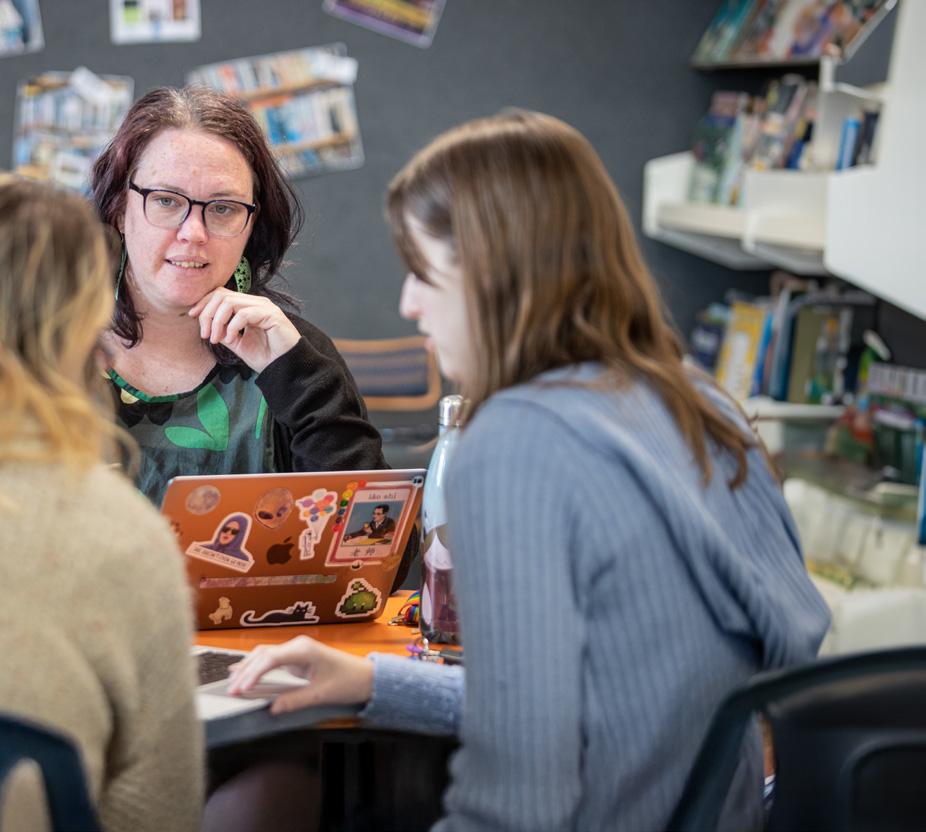
continues to evolve. Facilitators draw on their diverse experience and participant feedback to refine resources and align with national priorities.
Peer discussions at workshops surface emerging needs, and cross-sector collaboration strengthens inclusivity and relevance.
Courtney says the programme’s format made her feel supported and encouraged.
“I have enjoyed the whanaungatanga and feel supported with how this was presented in a format which was not overwhelming.”
“I wish I had done mentoring earlier in my life. I’ve learnt as much from beginning teachers as they have from me.”

Are you a Mentor Teacher, Pou Tautoko, Beginning Teacher, Overseas Trained Teacher or Pia in an early years, primary, or secondary setting?
Te Poipoi Kaiako offers self-paced and face-to-face learning for new and experienced Mentors and Pou Tautoko alongside their Tōmua | Provisional teachers.
Fully-funded, flexible learning and professional development leading to Tiwhikate Whakaakoranga Tūturu | Full Practising Certificate. Register to access local workshops, webinars, online modules, guidance resources, and workbooks.
Find out more and register at › core-ed.org/mentor-support
In partnership with
LEADERSHIP
Three experienced school leaders reflect on their time as leadership advisors for the Ministry of Education – a role that’s as much about giving back as it is about continuing to grow.
For Robin Fabish, Jackie Barron and Daniel Wilson, stepping into the role of leadership advisor wasn’t about stepping back from education – it was a deliberate decision to remain deeply connected to the work and the people shaping learning across Aotearoa.
“I was feeling like I needed a break from leading our kura,” says Robin. “Having been through Covid and Cyclone Gabrielle, I thought taking time out from principalship would be good for my wellbeing.
“This role has also given me the opportunity to stay in the educational leadership arena and make a contribution back to my colleagues.”
For Jackie, the role was a natural next step. “I was interested in giving back to the profession and being part of the solution instead of always criticising the Ministry for not doing enough for principals. I had knowledge and skills I was happy to share.”
Daniel also saw it as a progression. “After 10 years as principal of Nayland College, I felt it was time to continue my learning journey. What better way than to have the opportunity to work alongside school principals in an advisory role?”
On-the-ground support, shaped by experience
No two days are the same for leadership advisors, but each week is grounded in connection and collaboration.
Robin balances time in the office with school visits, principal association meetings and facilitating workshops. He’s also part of the team supporting the creation of leadership modules and podcasts for beginning principals.
Jackie reflects on the variety with enthusiasm, saying the work is “very varied, which is one of the things I really enjoyed”.
Jackie’s days include one-on-ones with principals, bringing groups of principals together to share experiences, attending stakeholder and sector meetings, and internal meetings with the Ministry.
Daniel structures his time around relationships. “Generally I tried to bookend the week – Monday and Friday were typically office days, connecting regionally and nationally –with Tuesday to Thursday working with principals in a variety of ways.”
Relationships built on trust and empathy
Building trust with principals, particularly those navigating complex challenges, was a priority for all three advisors.
“One of the key things is being out and about,” says Robin. “Being seen is important. I try to be as useful as possible to help tumuaki to solve their challenges and I think this builds trust. My understanding of the stresses and complexities that school leaders deal with means I can empathise and offer support.”
Jackie agrees. “Being a current principal was a big part of it. I was a bridge between them and Te Mahau. I build trust by listening and coaching – not telling people what to do or trying to fix their problems.”
Daniel adds: “Often I would be supporting principals through difficult leadership challenges, but this was not in isolation. The nature of the role and connection with existing principals inherently builds trust.”
Tailored support that makes an impact
Each advisor shares examples of impact made possible by this trust. For Robin, it’s the coaching relationships that stand out.
“By sitting alongside a tumuaki, sharing my experience and guiding problem-solving, I’ve created opportunities to clarify next steps. These are the conversations that transform schools.”
Jackie highlights the strategic planning workshops she ran. “We got very good feedback from those workshops indicating that they were really useful. This then led to follow-up work with smaller groups or individual principals.”
Daniel reflects on working closely with a principal around school culture, vision and strategic planning.
“Coaching essentially means considering the current situation, describing a desired situation, brainstorming pathways and then choosing a course of action.”



“By the end of the year the school was back on track, the principal was finally starting to enjoy their role and student engagement was on the improve.”
Support is always contextual and responsive. Robin explains that just like in a classroom, there are beginner principals and experienced principals.
“Less experienced tumuaki might need help with understanding Pourato and staffing, while more experienced leaders might like someone to bounce ideas off. Sometimes I have to go away and find the answers, or work with my team to respond to puzzles of practice.”
Jackie echoes this: “My role was about understanding, listening and coaching – valuing the different contexts and supporting principals to find their own solutions.”
whanaungatanga and continual learning
All three advisors draw on trusted frameworks in their mahi. Robin’s is guided by whakamana and manaakitanga.
“Honouring the mana of each principal I deal with is important to me. The essence of manaakitanga is kindness, generosity and looking after others.”
Jackie works from a growth coaching model and a simple principle: “Seek first to understand, then be understood.”
Daniel brings in frameworks like “Leading to the North East” and Viviane Robinson’s Student-Centred Leadership.
“The work is mostly relational,” he says. “And sometimes I was learning too. It was great to tap into the wealth of wisdom across the Advisor team.”
That spirit of collaboration is a cornerstone of the service. Robin, Jackie and Daniel all referenced regular hui, summits and online forums where advisors share ideas, challenges and best practice.
These interactions not only strengthen support for principals but also keep the advisors themselves learning and growing.
“You are continually learning in the role,” says Daniel. “You’re thinking as a principal would, through the eyes of a principal.”
With expressions of interest for 2026 now closed, each advisor shares the qualities that make this mahi meaningful.
“I’d encourage any experienced tumuaki to consider applying,” says Robin. “Key qualities are a solid commitment to equity and social justice, understanding of colonisation and our Te Tiriti history, an openness to learning, humility and a drive to serve.”
Jackie agrees. “Be open, transparent, a good listener, authentic and honest. Don’t get caught measuring busyness –focus on how you can make an authentic impact.”
Daniel adds, “Be willing to learn, flexible in your approach, prepared to travel, and most of all, work hard to form good connections and relationships.”


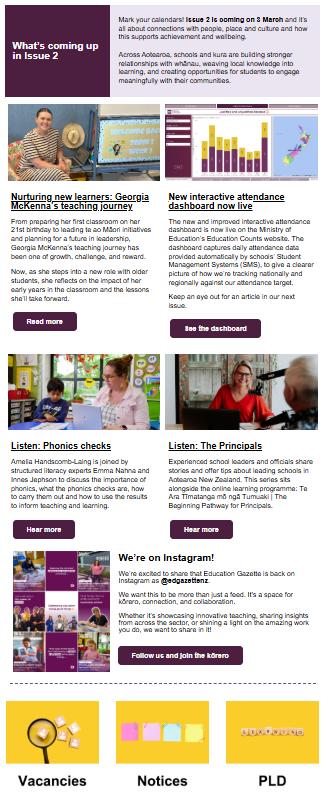
When it comes to your school’s digital security, knowing exactly who and what is connected to your Wi-Fi network is essential. More than 1,000 schools have taken up Network for Learning’s Secure Access tool, a network access control that provides greater visibility over Wi-Fi networks.

An important advantage of Secure Access is control; its segmented network lets the school set different access levels for ākonga and staff.
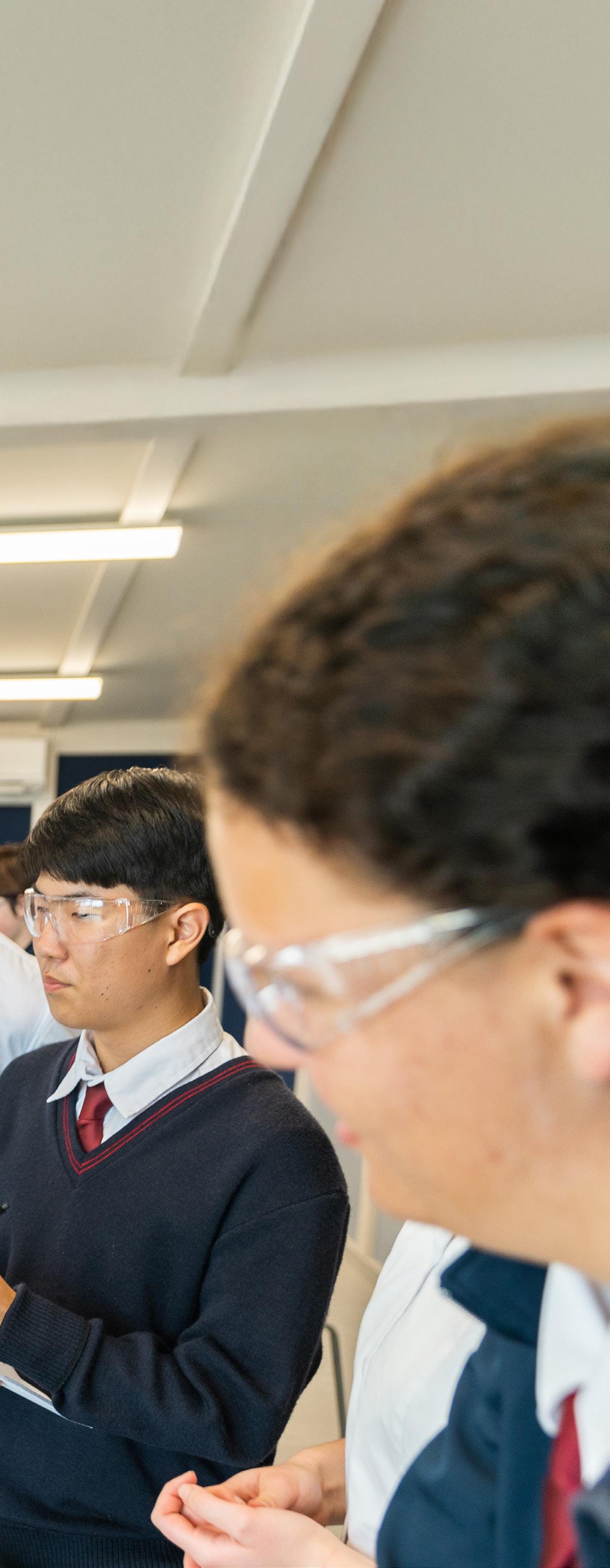
Mt Roskill Intermediate is just one of many schools to have realised the benefits of Network for Learning’s (N4L) Secure Access tool. The school is gaining a more secure learning environment but also enjoying a seamless migration process with no disruption.
The central-south Auckland school has around 600 ākonga accessing learning technology daily. The school’s bring-yourown-device (BYOD) policies allow students to seamlessly integrate their devices, while each classroom is equipped with around 20 Chromebooks.
For kaiako, the set-up leans heavily on Apple – with laptops, iPads, iPhones and TVs spread across the 19 classrooms.
Like any school utilising a lot of tech, they faced several challenges, but one of the biggest was managing guest access to the school’s Wi-Fi network and also securing ākonga BYODs.
“Sometimes, we’d give out staff access [to visitors] just to make things easier, which wasn’t very secure,” says deputy principal Nicky Fleming.
With Secure Access, Mt Roskill can now manage who connects, what they can access and how protected the network is.
N4L encourages schools to think about how carefully they monitor who enters school grounds – and then apply that to who is accessing the digital environment.
Without the right controls in place, anyone connecting to a school’s network, even briefly, can potentially open the door to cyber threats, which can put ākonga data, school operations and personal information at risk.
And it isn’t just data that’s vulnerable. A cyber-attack can also impact equipment critical to the day-to-day running of a school – from printers and VoIP (Voice over Internet Protocol) phones to heating and air conditioning systems.
In more severe cases, staff computers may be compromised, sensitive data stolen, or there could be ransomware demands.
N4L’s Secure Access helps stop this at the gate. Here’s how it works:
» Manage user groups: Secure Access allows control of how ākonga, kaiako and guests access school Wi-Fi. It enables schools to tailor what each group can do online, based on what’s right for their community.
» Identity-based access: Each person and device is securely authenticated and authorised before joining the network.
This ensures only trusted users connect and that access reflects their role in the school.
» Improved security through segmentation: A school’s network is split into separate, more secure zones for staff, ākonga and guests. That way, even if a breach happens, it’s contained – which helps critical data and systems stay protected.
Together, these features help schools shift from open, onesize-fits-all networks to tailored, more secure environments that are easier to manage and better aligned with how schools operate.
When Mt Roskill Intermediate migrated to N4L’s Secure Access, it saw immediate improvements in its security and day-to-day operations.
An important advantage of Secure Access is control – its segmented network lets the school set different access levels for ākonga and staff. It means ākonga can’t access staff documents or interfere with administrative systems, keeping the network more secure.
“Secure Access lets us easily enforce the ākonga access rules we have. It also makes us less vulnerable if we were ever attacked,” says Nicky.
Nicky adds that it’s now much easier to handle guest access to the school’s Wi-Fi network. The school can just email a key or send a QR code for entry, making everything simpler and providing more control.
Mt Roskill says it was pleasantly surprised by how the transition to Secure Access had so little impact on the dayto-day running of the school, attributing this to the work everyone put in to preparing for the change-over.
As there was the complexity of kaiako using Apple devices and ākonga working from Chromebooks, it was also crucial
that Secure Access would work with both technologies.
“The migration process was really good,” says Nicky. “On the day, I woke up and thought, ‘Oh no, the phones might not connect to the Chromebooks!’ but N4L was pre-empting issues. It was all sorted out before we needed it.
“It’s a lot more painless than you might think. We thought we’d lose our whole internet for the day, but we didn’t. They were so organised.”
Schools that have completed Equipment Replacement can be scheduled for Secure Access migration and details will be communicated by N4L.
Eligible schools can request to be added to the schedule by contacting N4L.
N4L is migrating schools over to Secure Access in a staged rollout, meaning they’ll reach out when it’s each school’s turn to get the upgrade.
Schools can find out more by contacting N4L’s Customer Support team at support@n4l.co.nz or 0800 532 764. Or, visit n4l.co.nz/protect/safety-and-security-solutions/secureaccess
“Secure Access lets us easily enforce the ākonga access rules we have. It also makes us less vulnerable if we were ever attacked.”
185,000
ākonga connected to the Secure Access networks
13,000 kaiako connected to the Secure Access networks
1,000 schools migrated to Secure Access
115 IT Panel member technicians working on the migrations
300 customer insights received from schools
Go to education.govt.nz/ls-study-awards
Applications are now open for the Ministry of Education’s learning support study awards.
These Massey University distance courses are an opportunity for teachers in early learning services, schools, and kura to undertake specialist qualifications alongside their work.
The courses are designed to help kaiako to better support tamariki and ākonga with additional learning needs.
Funding is provided to cover tuition fees, some study leave days from work, and contributions towards travel costs.
Applications close 12 September 2025
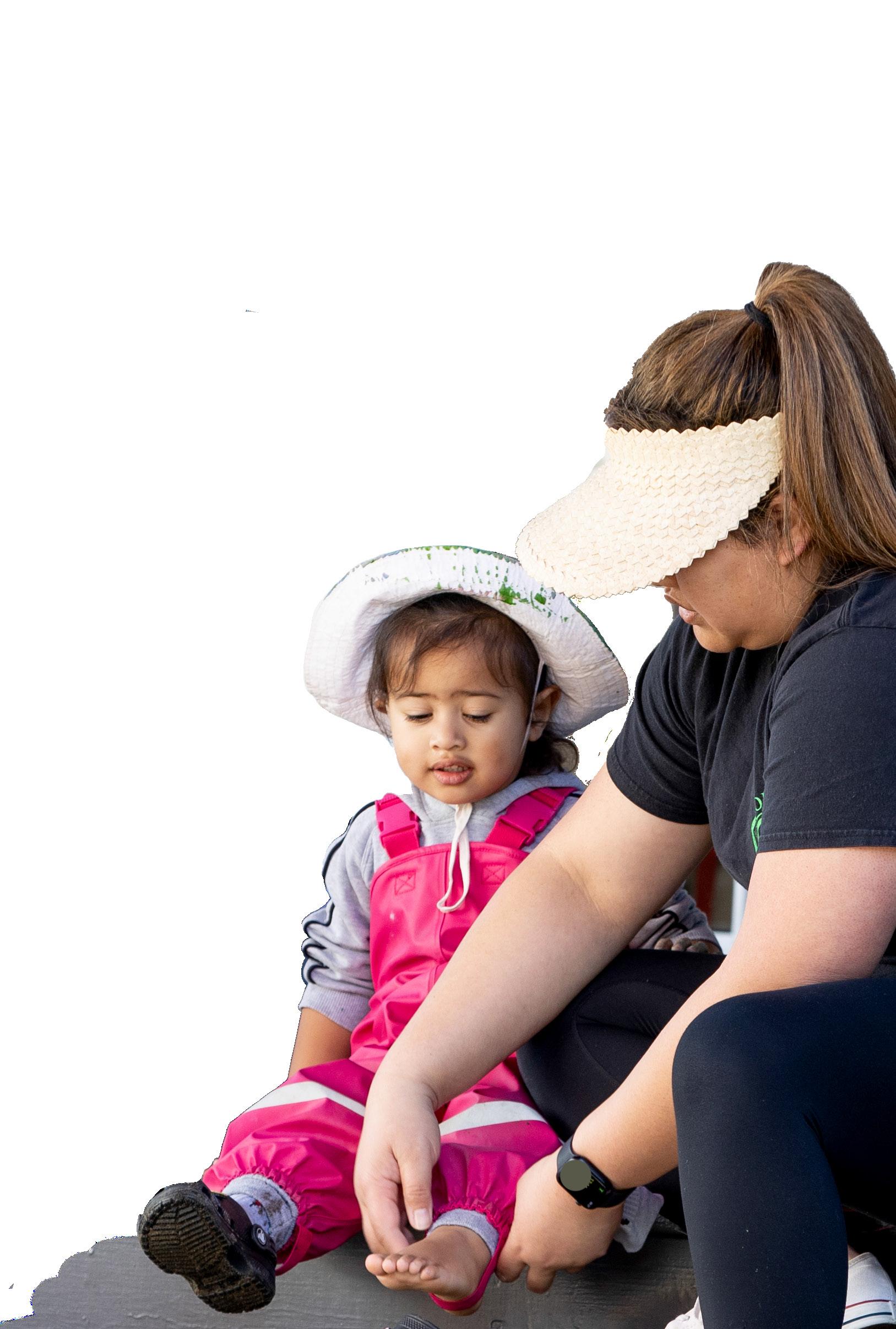
For all the information on eligibility and how to apply, head to our website or the links below:
• Advisers on Deaf Children (AoDC) Study Award
• Blind and Low Vision Study Award
• Complex Educational Needs Study Award
• Deaf and Hard of Hearing Study Award
• Early Intervention Study Award
• Gifted Study Award
• Research Teachers Learning and Behaviour Study Award
When 15 students from migrant and refugee backgrounds took to the stage at a national Shakespeare festival with a centuries-old monologue on displacement, they didn’t just perform Shakespeare – they reshaped it.
“Imagine that you see the wretched strangers, Their babies at their backs and their poor luggage, Plodding to the ports and coasts for transportation.”
Sophia uttered these words as two of her companions dropped to the ground and started crawling, carrying bundles on their backs.
Fifteen students, who mostly had immigrant, international or refugee backgrounds, were reimagining a monologue spoken by the character of Sir Thomas More in a 16th-century play of the same name.
The monologue was the centrepiece of their performance, The Strangers’ Case, at the Shakespeare Globe Centre NZ (SGCNZ) VUW 2025 National Shakespeare Festival, held at the St James Theatre in Wellington.

You didn’t know Sir Thomas More was a Shakespeare play? Well, it isn’t. But a three-page handwritten revision of its monologue was recently discovered, and is strongly believed to be written by Shakespeare, and to be the only surviving script in Shakespeare’s handwriting.
The play Sir Thomas More is based on real events. On 1 May 1517, rioters began attacking foreigners who had immigrated to London from Lombardy. Lord Chancellor of England Sir Thomas More delivers a monologue addressing rioters: describing the plight of refugees (called ‘strangers’) and asking the rioters to imagine themselves in the strangers’ shoes.
Dawn Sanders, who runs SCGNZ, asked the Shakespeare Globe Centre in London if the monologue could be acknowledged as part of Shakespeare’s canon and performed for the festival – and they didn’t just say yes – they were excited by it.
The students got permission to include the words ‘Gaza’ and ‘Ukraine’, because of consensus on their modern-day relevance.
“Everyone in the rehearsal room discussed whether that was too pointed,” says director Tama Smith, “but we felt the urgency of making those references to drive the message home.”
In their ensemble performance, the students divided More’s lines between them. They each translated some of the words into their first languages – Italian, German, Thai, Taiwanese, Mandarin, Russian, Japanese, Spanish and Māori – and spoke those words onstage either before or after the English words, creating an echo of sorts.
They moved around the stage, some carrying luggage, or a bundle representing a baby, to convey the forced movement of displaced refugees, who are now searching sanctuary.
A soundscape (created by teaching assistant Nyal) built tension to a threatening climax. Sometimes they cowered in terror. When a noise suggested planes above, they shivered with fear – and when what sounded like a bomb was dropped, they screamed and scattered. Cracks and groans and music suggested storms, waves and climate catastrophes.
They got a deafening standing ovation and received four awards: Most Original Choice of Play, Most Imaginative and Innovative Production, Extraordinary Performance, and Most Thought-Provoking Performance.
The recognition meant a lot. Tama told the group they weren’t just performers. “You were visionaries, collaborators and truth-tellers.”
A theatre-maker, arts educator and the Wellington regional representative for SCGNZ, Tama is also the arts coordinator at Wellington High School, where he teaches an ESOL class for new-immigrant students.
A teaching assistant from that class, Daniela, is a member of the NZ National Refugee Youth Council.

“Similar events and issues are being discussed in the same ways and words now as they were in the 1500s.”

The council and Mamaku (through which Tama runs community-arts performances) proposed a collaboration to SCGNZ. The production would use words, movement, sound and ensemble storytelling to convey refugees’ experiences.
Tama hoped to find some refugee students to take part, but that was easier said than done. So he approached Wellington High School rangatahi whose families immigrated here or who have international or multicultural backgrounds.
Although Tama doesn’t run drama classes at the school, he knows a lot of students and their backgrounds, personalities, talents and ways of expressing themselves.
The modern-day relevance drew students in. It struck the students that the treatment of immigrants and refugees hasn’t really changed in half a millennium.
As Sophie says: “Similar events and issues are being discussed in the same ways and words now as they were in the 1500s.”
Eru was already super busy with kapa haka and waka ama when Tama “roped him into this random Shakespeare thing”.
“I thought ‘why not?’ It’s something interesting I’ve never done and it could be fun’.”
The initial cast was 10 students (including a Wellington Girls’ College exchange student) plus a student violinist, Ben.
In their performance, they spoke Shakespeare’s original lines as per festival rules. Tama had earlier ‘translated’ the lines into modern-day English simply to help the students better understand it.
Here’s some of his modernised text.
“Imagine if the king, who is kind and forgiving if you understand you have done wrong, only punished you by sending you away – where would you go? What country would take you in if you made the same mistake?”
That helped them better understand the original text that they would speak:
“As but to banish you, whither would you go? What country, by the nature of your error, Should give you harbour? Go you to France or Flanders, To any German province, to Gaza or Ukraine, Nay, anywhere that not adheres to England, Why, you must needs be strangers: would you be pleased to find a nation of such barbarous temper.”
The students were empowered to contribute to all aspects of the production, from choreography to directing to translation.
Sophie, whose Russian family immigrated here five years ago, was associate director.
“Sophie was really helpful in figuring out how to go from words on a page to conceptualising what it will look like in space,” says Tama.
As for the choreography, Sophie and her ballerina friend Rachel tried out the dance-like movements (initially in a playground) then workshopped these with other members.
“It was transforming how we felt into movement,” says
Sophie. Rachel choreographed and performed a moving ballet piece within the work.
After two hours of rehearsals on Wednesday and Friday afternoons for two months, they performed The Strangers’ Case at the SCGNZ Wellington Regional Festival in April.
Praised for its originality, courage and emotional power, it was selected to represent the region at the national festival on King’s Birthday weekend.
The students had always felt the responsibility to properly represent refugees. But with the nationals looming, they decided to try even harder to find refugees to join the group.
Four refugee young people aged 15 to 18 and living in Levin came on board; their families are from Colombia and Venezuela. One mother and father drove them from Levin to Wellington and back twice a week for a month.
“As I was directing,” says Tama, “Daniela was immediately translating lines into Spanish. Finding understanding beyond language challenges was central for us throughout.”
Culturally and linguistically, the students really did make Shakespeare their own.
Sophia says most of the refugee students didn’t have great English, and she doesn’t have great Spanish. But they had enough to communicate about the play.
“There was laughter and respect – they were spending so much time travelling.”
Having four more actors enabled the group to ‘do more’ –particularly in the ocean scene. As they heard what sounded like revving engines of boats, some of the actors swayed back and forth onstage.
Four others walked onto the stage, with only their toes visible because they were wearing rectangles of silver tinfoil to represent the sea between North Africa and Europe that migrants try to cross, fleeing war, persecution and poverty.
Many boats don’t make it. When the performers left the stage, they left their things strewn around.
“We wanted to get flotsam and jetsam, which represents that urgency, into the performance. And that horrible fact that some people couldn’t hold onto their children.”
The students found all this confronting.
“It’s been 500 years since this play,” says Sophia, “and what’s changed? It’s so important that we keep shedding light on terrible actions towards refugees and displaced people. I felt the weight of it. It was more than a role. After our final performance, I cried.”
Eru had to run off to do kapa haka but gave another student a quick hug first. Some needed hugs, others needed alone time, and others were approached by students wanting to discuss the material.
Sophie gave Tama what they called “a challenge,” early on. “It was partly about avoiding victimisation,” says Sophie.
“Instead, we wanted to have a dialogue with the audience that doesn’t lead them to be terrified or sad but might mean they go do whatever they can to try to change things.”
Starting out together on their journey away from turmoil and danger, a baby was carefully passed between father and mother.
Established and run by Dawn Sanders, Shakespeare Globe Centre New Zealand (SGCNZ) held its first Shakespeare Festivals in seven regions in 1992.
Since 2017 there have been 24 regional festivals annually (minus the odd one owing to weather events and Covid).
Selected groups from the regionals perform in Wellington at the national festivals (there have been 34 so far).
The scale of impact:
» 145,500 students have now participated in festivals nationwide over the past 34 years.
» 1,316 students have attended SGCNZ National Shakespeare Schools Production: a nine-day course with around 50 students chosen from the regionals and nationals.
» 672 students have been chosen to go to The Globe in London as members of SGCNZ Young Shakespeare Company.
» 71 SGCNZ Teachers Go Global have been in the special biennial programme for school and community theatre teachers at The Globe in London.
SGCNZ measure success partly through student feedback from questionnaires at the national festival and regional festivals.
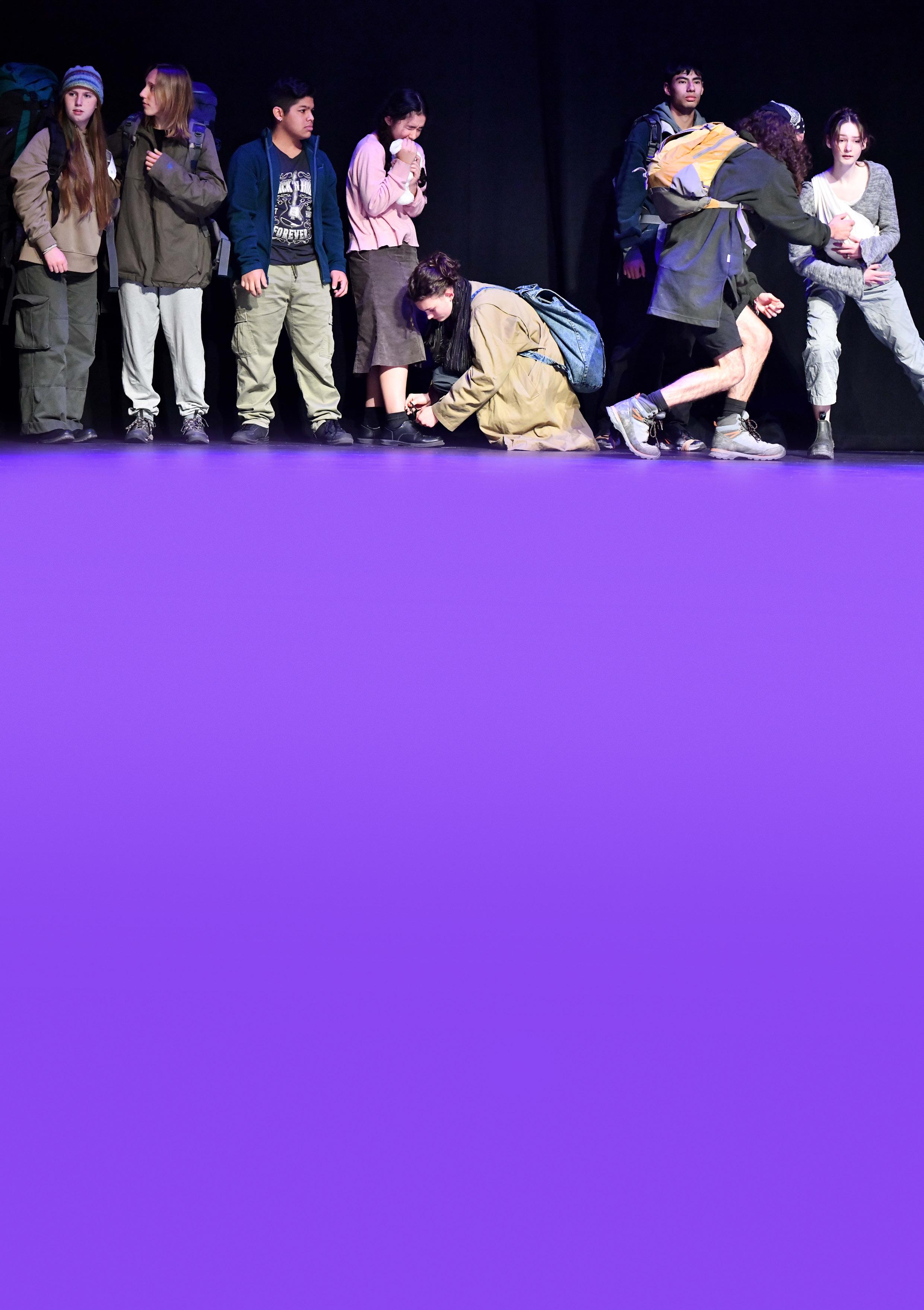
When asked ‘why’ they loved being part of the festivals, Dawn says their reasons include:
» learning how to understand Shakespeare’s text
» close reading that benefits their learning
» discovering the parallels of themes today – social, political, personal
» realising how much Shakespeare is about human relationships
» finding out the old and new meanings of the words
» having fun with puns and parodies, allegory and alliteration
» collaborations that will continue in future years.
“Feedback is overwhelmingly positive. The words ‘life changing’ are the most common reaction,” says Dawn.
“Where there are constructive criticisms, these are evaluated and alterations are made as and where appropriate and applicable.”
How has feedback shaped the festival and its flow-on events?
Dawn says that the SGCNZ National Shakespeare Schools Production has morphed from being a seven-day event, to nine., in association with the young people ‘reshaping’ the format.
“The actual ‘shape of the festival’ has been tweaked over the years. I have youth observers on the board, whom I consult, plus an informal youth advisory group.”
Alternative education (AE) programmes across Aotearoa are supporting students who disengage from education to reconnect with learning, develop confidence, and plan for their futures. Recent research and student voices highlight what makes these programmes successful, and how educators can build on that success. Dr Lloyd Martin explains.
Over the past few months, a series of media stories have highlighted positive outcomes for former students in alternative education (AE) programmes. These reflect what many educators and students already know: when AE is designed around relationships, flexible learning and trust, it can be life changing.
A recent study Don’t Give Up On Us (Martin, 2024), followed a cohort of ākonga across six AE programmes for a year; it focused on what was changing for them, and what they thought was helping to create those changes.
Their answers to the second question were clear: having a stable connection with a positive adult; getting individualised support with their work in a safe space, and learning at their own pace.
School disengagement is often part of a wider set of difficulties that a young person is dealing with. The students who took part in the 2024 study were also dealing with personal loss, abusive situations, isolation and other forms of adversity.
Compared with the general student population, students who have been referred into an AE programme are (for example) 25 times more likely to have had an FGC (family group conference), nine times more likely to have been in the care of Oranga Tamariki, and four times more likely to have been referred to a specialist mental health service (source: ERO 2023).
If the rest of their life is a struggle, students who are going through adversity have an even greater need for school to be a safe and supportive place. However, the ākonga in the 2024 research cohort reflected that their experiences had left them unprepared to cope with a large secondary school environment, where all reported feeling unsafe.
Many young people arrive at an AE programme in a crisis, which is often a result of their experiences at both home and school.
A trauma informed approach begins with the question, “What works to help them re-engage”?
The first phase of AE involves supporting ākonga through their crisis, a process that can take anything from weeks to months.
This is an essential part of the journey, yet this work is often invisible in traditional metrics. If most students arrive at an AE programme in survival mode, the biggest issue identified by those in the research cohort was finding an adult that they connected with and could trust.
Building trust is often underpinned by practical care. Most AE programmes stretch their limited resources to meet a wide range of practical needs, including transport, food, clothing, counselling and health support.
With their mum in and out of mental health care services, one of the students in the research cohort had got to the point where they felt able to share with their AE tutor when there was no food at home. Going to the supermarket together to fill a couple of bags with groceries from time-to-time built trust and created an opportunity to work on some practical maths.
Teaching to the North-East, Russell Bishop’s (2019) work on relationship-based learning resonates with good practice in alternative education.
Effective AE programmes navigate a balance between creating a supportive and safe community and maintaining a culture of high expectations around what their students are capable of.
As Russell has noted, high expectations alone just get their backs up, and low expectations of what they are capable of are corrosive to good educational practice.
Much earlier, Anton Makarenko, a Ukrainian pioneer in alternative education who died in 1939, challenged a group of school leaders to ‘see the potential in every young person’. He added that for those that we can’t, we are probably doing more harm than good.
Effective approaches to re-engaging AE students also comes from understanding how the disciplines of education and youth development overlap.
The ability to focus on a task, work cooperatively with others and carry out an intended action are developmental issues, but according to [Russian psychologist Lev] Vygotsky these abilities also create a foundation for higher levels of learning.
The development of these psychological assets is impacted by traumatic experience, and for many AE students, unmet
developmental needs have been at the root of their spiralling disengagement from education.
Addressing developmental issues is critical to helping students through the first phase. These are met in the context of positive connections and multiple ‘mini experiences’ in scaffolded social situations.
As summarised by Brendtro et al. (2019), developmental experiences help to:
» Instil a sense of belonging
» Foster experiences of mastering a skill
» Build trust through responsibility
» Engage students in generosity toward others. For children who grow up with stable attachments, these experiences occur naturally. They are often missing for those who haven’t.
The second phase involves re-engagement with learning. By the time they are out of survival mode and are beginning to think about their future, most AE students have missed significant chunks of work, and many only have a few months left of their time in AE. Simply trying to catch them up with learning can reinforce an ongoing sense of failure for those who are most behind.
Most of the students in the research cohort talked about wanting to enter a trade. However, the 2023 ERO report into Alternative Education found that only one in five students currently get to the first step in meeting the entry criteria for a trades course.
If we are to break future cycles of dysfunction and involvement in the justice system, our challenge is finding innovative ways to ensure that AE students are able to achieve a tohu that reflects what they have accomplished and better supports them toward their goals.
The Ministry of Education describes AE as a pathway to school, further education, training, or employment. These are all outcomes that create new possibilities for the young people involved. It is time for a further conversation about more effective ways to achieve this vision.
Education Gazette: Alternative Education model in Porirua grounded in trust and youth work
Bishop, R. (2019). Teaching to the North-East, relationshipbased learning in practice. NZCER Press.
Brendtro, L., & Brokenleg, M. & Van Bockern, S. (2019). Reclaiming youth at risk: Futures of Promise (3rd Edition). Solution Tree Press.
Education Review Office (2023). An Alternative Education? Support for our most disengaged young people. Te Ihuwaka, Education Evaluation Centre.
Martin, L. (2024). Don’t give up on us, young people’s experiences of change in alternative education (Ed.D. thesis). Te Herenga Waka, Victoria University of Wellington.